Оборудуем зону для сайклинга: какие байки покупать и сколько их нужно
Сайклинг – это упражнения на спин-байках. Внешне они схожи с обычными велотренажерами. Тренировки имитируют велосипедные гонки, которым присущи: неограниченная скорость, спортивный азарт, неровные трассы и мышечная нагрузка. Спортсмены садятся на байки, чтобы развить выносливость или сбросить вес.
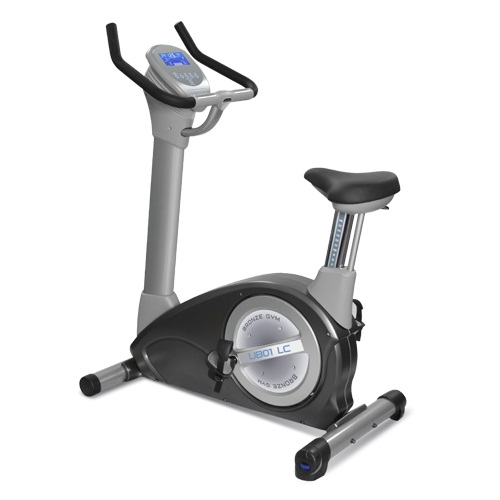
Что такое сайклинг
Сайклинг – это упражнения на спин-байках. Внешне они схожи с обычными велотренажерами. Тренировки имитируют велосипедные гонки, которым присущи: неограниченная скорость, спортивный азарт, неровные трассы и мышечная нагрузка. Спортсмены садятся на байки, чтобы развить выносливость или сбросить вес.
Технически спин-байки и велики относятся к кардиотренажерам. Начинающие спортсмены думают, что эти две машины выполняют одни и те же функции, поэтому легко заменяемы. В этой статье мы объясним, в чем разница и как выбрать спин-байк для своего зала.
Тренажеры и байки: отличия
Положение спортсмена на тренажере. На велотренажере спортсмен выполняет упражнения сидя.
На спин-байке, как и на шоссейнике, ездок постоянно двигается – сидит, стоит, полусидит. Такое положение отражается на результате тренировок в пользу спин-байка.
Регулировка руля и седла. На спин-байке регулируется как посадка, так и руль. В тренировке задействуются мышцы ног, развивается вестибулярный аппарат.
Начинка обычного велика скромнее: нет гибкой регулировки, педали не предназначены для вертикальной нагрузки – стоя на нем не покатаешься. Велотренажер приводит в тонус только мышцы ног.
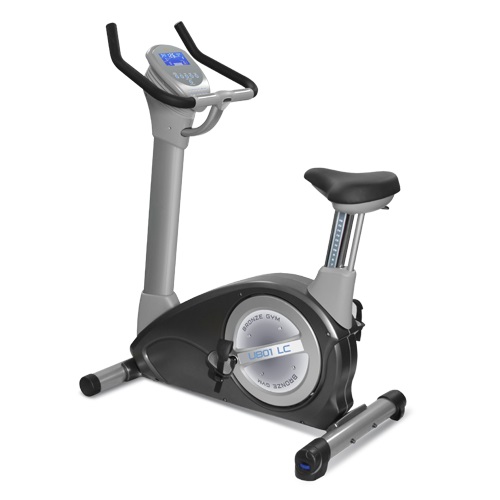
У велотренажера ограничена регулировка сидения
Тип нагрузки. У спин-байков бесшаговая динамическая нагрузка. Максимальная скорость разгона не ограничивается ничем, кроме физических возможностей атлета.
Обычный велотренажер обладает пошаговой нагрузкой. Спортсмен подбирает скорость по своим силам, но не установит ее выше максимально заданной. Обычно это 35–40 км/ч.
Техническое обслуживание. При постоянных и интенсивных тренировках у спин-байка постепенно стираются цепь, колодка и зубья болта. В среднем, эти механизмы изнашиваются за 1–2 года. Детали легко и не затратно менять.
У обычных велотренажеров практически нет изнашиваемых запчастей. Но если велик сломался, то придется потратиться на услуги мастера-механика или приобрести новое оборудование.
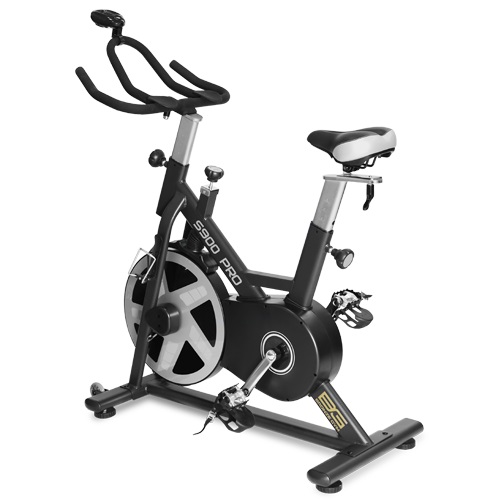
У этого тренажера есть рама и регулируется руль
Где используется тренажер. По своим параметрам велотренажер подходит для фитнеса или медицинской реабилитации. Их можно встретить в кардио-зонах классических тренажерных залов. Там они необходимы для разогрева перед основной тренировкой или снятия мышечного напряжения после.
Спин-байки пользуются популярностью в залах для функционального тренинга, на тренировочных базах профессиональных спортсменов. Также их используют в фитнес-центрах, где организуют отдельные группы по сайклингу.
При выборе между спин-байком и велотренажером стоит помнить о том, что спин-байк включает в себя функционал обоих устройств, а велосипед прокачать невозможно.
Если тренажерный зал со спортивным уклоном – отдайте предпочтение спин-байкам. Полупрофессиональные модели находятся в одной ценовой категории с велотренажерами – 40–50 тысяч рублей.
Если зал создан для реабилитации – простого велотренажера будет достаточно. Стоимость такого оборудования от 25 тысяч рублей.
Спин-байк для фитнес-центров
При покупке тренажера тренеры советуют обращать внимание на маховик, педали и комфортность седла. Вес маховика влияет на нагрузку, педали позволяют надежно фиксировать ноги, удобное седло гарантирует правильную посадку.
Обратите внимание на показатели предельного веса пользователя. Они определяют, для какого использования подходит спин-байк:
- Тренажеры с максимальным весом пользователя до 130 килограмм устанавливают в фитнес-клубах с малой и средней проходимостью.
- Спин-байками с порогом нагрузки от 150 килограмм оборудуют фитнес-клубы с высокой проходимостью или сайклинг-студии.
Средний ценник на спин-байки для фитнес-клубов со средней проходимостью – 45 тысяч рублей. Тренажеры этой ценовой категории имеют необходимый интерфейс с подсчетом калорий, скорости и пройденной дистанции.
За один профессиональный спин-байк придется отдать от 55 до 90 тысяч рублей. Главное отличие этих тренажеров – увеличенный максимальный вес пользователя, утяжеленная с целью повышения прочности рама. Сиденья и руль регулируются в горизонтальном и вертикальном положениях.
Какие модели спин-байков подойдут для клубов
В каталоге Iron King представлены модели спин-байков PRO MATRIX ES и BRONZE GYM S1000.
Особенности PRO MATRIX ES
Профессиональный спин-байк PRO MATRIX ES с вертикальной посадкой и высокопрочной оцинкованной рамой выдержит пользователя до 136 кг. Спортсмен с любым телосложением настроит удобную посадку для комфортной тренировки.
Маховик весом в 21 кг обеспечивает максимальную нагрузку. Спин-байк не требует подключения к сети. Американская фирма-производитель Johnson Health Tech дает 5-летнюю гарантию на свой тренажер.

Этот спин-байк подойдет для фитнес-центров с высокой проходимостью
Достоинства:
- Сидение и руль регулируются по вертикали и горизонтали.
- Руль не выскальзывает из рук благодаря мультипозиционным прорезиненным рукояткам.
- Педали из легированной стали с туклипсами и фиксирующими ремнями плотно держат ступни во время занятий спортом.
Недостатки:
- Нет консоли и пульсометра.
- Только механическая настройка тренировочных программ.
Цена: 88 890 рублей.
Особенности BRONZE GYM S1000
Тяжеловесная 60-килограммовая модель спин-байка с вертикальной посадкой и компенсаторами неровностей пола.
Этот спин-байк создан для спортзалов и сайкл-студий с высокой проходимостью. Максимальный вес пользования у этой модели действительно королевский – 181 кг, 22-килограммовый маховик с алюминиевым ободом обеспечивает интенсивную тренировку всех групп мышц и развитие выносливости.
Как и предшественник, эта модель спин-байка не складывается, но ее можно передвигать благодаря полиуретановым транспортировочным роликам. Фирма-производитель Neotren GmbH (Германия) дает гарантию 1 год на спин-байк этой модели.
The 7 Best Single Speed Bikes – [2021 Reviews]
Enjoy the simplicity of a bike with one speed, we break down this year’s top single speed bikes

Our Editors independently research, test, and rate what we feel are the best products. We use affiliate links and may receive a small commission on purchases.
The best single speed bicycles offer a basic and straightforward cycling experience. With their unique advantages over other types of bikes, single gear bikes have been gaining in popularity.
Many riders prefer these simple bikes for exercise, commuting or just for pleasure. Single speed bikes are low-maintenance, simple to ride and very lightweight.
If you’re interested in a “fixie bike” see our reviews here.
Best Single Speed Bikes
| Schwinn Single Speed Fixie Bike | State Bullhorn Single Speed Bike | Captain Marvel Single Speed Bike | |
|---|---|---|---|
 |  | ||
| Frame: | Steel | 4130-grade chromoly steel | Steel |
| Gearing: | 46:18 | 46:14 | 46:16 |
| Handlebars: | Riser | Drop | Riser |
| Wheels: | 700c | 700c | 700c |
| Bike Helmets, Bike Lights, Bike Locks. |
Quick Answer: The 7 Best Rated Single Speed Bikes For 2021
Our reviews of the top rated single speed bikes with our guide and comparison table will help you choose the right bike for you.
Single Speed Bike Reviews
#1 Schwinn Single Speed Fixie Bike

- Size: 58 cm/Large frame
- Gearing: Flip-flop hub, 46:18 ratio
- Handlebars: alloy riser bar
- Wheels & Tires: 700 c wheels
- Frame & Fork: steel frame
- Brakes: Front and rear alloy caliper brake
The Schwinn Single Speed Fixie Bike stands out for its great features and build.
Efficient yet comfortable, this model offers an urban seat and grip for added cushioning at key touch points.
The steel racing frame and fork offer a reliable and agile ride, perfect for commuting from place to place. The no-frills fixie styling also means less maintenance on your end
On this bike, you will find front and rear alloy caliper brakes for enhanced safety, as well as a versatile flip-flop hub which includes a freewheel and fixed cogs for convenient fixed-gear capabilities.
This means the rear wheel can be flipped to the other side, giving you the choice between free-wheel coasting or true fixed-gear riding.
This is a practical and efficient bike that you really can’t go wrong with.
#2 State Bullhorn Single Speed Bike

- Size: 46cm/XS, 62 cm/L
- Gearing: Flip-flop hub
- Handlebars: Pista race drop handlebars
- Wheels & Tires: rubber
- Frame & Fork: 4130-grade chromoly steel
- Brakes: Front & rear alloy caliper brakes
The State Bullhorn Single Speed Bike is a high-grade, aggressive race bike. It is made for uphill biking, sprints and climbs.
This is a model for advanced riders who are looking to race on the track but still be able to bike in urban environments.
The double-butted 4130-grade chromoly steel used on the frame and fork maximize strength without making compromises on weight.
The frame and tubing are designed for the track and paired with a shorter stem, drop down handlebars, and a slightly raised rear chain stay.
This bike takes speed seriously, but it also makes sure to incorporate key safety features.
Front and rear caliper brakes ensure a clean and crisp stop no matter the terrain or speed you choose to ride at.
It is available in both 46 and 62 cm as well, for riders of all sizes.
#3 Captain Marvel Single Speed Bike

- Size: 58cm/L
- Gearing: Flip-flop hub, 46:16 ratio
- Handlebars: Alloy riser handlebar
- Wheels & Tires: 700c x 28c tires
- Frame & Fork: Steel fork and frame
- Brakes: Dual caliper brakes
The Captain Marvel is a bike that has been designed for all-around use.
With a 46tx 18t single-speed drivetrain and versatile flip-flop hub, this bike includes both freewheel and fixed cogs for convenient versatility.
The dual alloy caliper brakes supply crisp all-condition stopping power and the high-profile alloy rims are light and strong, offering crucial stability and durability.
This bike also features authentic Captain Marvel graphics and colors – perfect for the superhero enthusiasts out there.
Designed with 700C (28-Inch) wheels, this bike’s suggested rider height is 5’4″ to 6’2″ tall.
This is a great general-use bike that will last for years with its simple, reliable construction.
#4 Takara Sugiyama Single Speed Bike

- Size: 58 cm/L
- Gearing: Flip-flop hub
- Handlebars: Flat bar handlebars
- Wheels & Tires: 700 x 32 alloy wheels
- Frame & Fork: Hand crafted steel frame
- Brakes: Front & rear alloy side pull brakes
The Takara Sugiyama is all about keeping things simple and getting it done without breaking the bank.
At the heart of the Sugiyama you’ll find a strong hand crafted steel frame with horizontal dropouts that can handle the abuse of the big city.
This bike comes with a flip flop hub so you can run it as a fixed gear or in standard freewheel single speed mode, without having to worry about making adjustments.
Thanks to the 32-hole alloy wheels and loud 700 x 32 tires, the Takara Sugiyama is capable of withstanding less-than-perfect roads.
It also includes front and rear alloy side pull brakes for a safe and speedy stop.
With this bike, you’ll find handling city traffic with many starts and stops straightforward. It is as practical as it is cool.
#5 Raleigh Bikes Tripper City Bike

- Size: S (51cm), M (54cm), L (57cm), XL (60cm)
- Gearing: Flip-flop hub, 42:16 ratio, KMC Z410 chain
- Handlebars: Alloy, 620mm Wide, 25mm riser bar with 5° backsweep
- Wheels & Tires: Alloy double wall rims, Kenda 10818 700c x 25c tires
- Frame & Fork: High tension steel frame, track geometry
- Brakes: Alloy dual pivot caliper front & rear brakes
The Raleigh Tripper City Bike is a street bike, as the name suggests.
Beating traffic, commuting to work, racing down hills or going for errands, the Back Alley bike is all about efficient cycling.
The high tension steel frame features a track geometry and is paired with a steel fork to absorb shocks and bumps.
The manufacturer goes back to features of early bikes to deliver a model that is all abyellow and four different sizes. Consult the sizing chart for picking the right one.
The cable guides for the front and rear brake are completely removable, in case you want to make use of the flip flop hub and convert this ride from a single speed into a fixie without brakes.
Otherwise the dual brakes serve you well in traffic. The gear ratio of 42:16 lends itself well to inner-city cycling. The wheels come with double wall rims and Kenda 700c tires.
The handlebar is nearly flat and mildly swept back. With the comfortable seat, you ride upright and have a good view of what’s ahead.
If the limited color choice doesn’t put you off, this is a great single speed bicycle for urban riding for around $400.
#6 6KU Aluminum Single-Speed Urban Track Bike

- Size: XX-S (47cm), XS (49cm), S (52cm), M (55cm), L (58cm), XL (61cm)
- Gearing: Single speed, 42:16 ratio, KMC Rustbuster chain
- Handlebars: Promax 15 degree 20mm rise
- Wheels & Tires: 700c x 25c puncture-resistant tires
- Frame & Fork: 6061 aluminum frame with road geometry
- Brakes: Promax Dual Pivot Caliper with quick-release arms
The 6KU Urban Track Bike is a single speed commuter model designed to survive the city.
This includes a lightweight yet sturdy aluminum construction, puncture-resistant tires, and extra security measures.
With this model, you will get protection from shocks and the elements: aluminum makes for a rust-free bike. The 6061 aluminum frame is lightweight and sturdy and constructed for road riding.
It also includes Delta Fort Knox locking hub nuts to secure the wheels. With the Fortified Theft Protection Plan, you will even receive a free U-lock.
Dual brakes mean adequate stopping power, and the drivetrain gives you a nice 42:16 ratio which many urban riders find ideal for good pedal cadence and top speed.
The 700c by 25c tires are puncture resistant and give you sufficient shock absorption when riding over minor obstacles or jumping a curb now and then.
If you’re serious about commuting to work and riding in the city a lot while valuing the single speed approach and gearing, the 6KU Track Bike is for you.
It’s the best urban single speed bike with it’s theft resistance features.
#7 Giant Simple Single Speed Bike

- Size: One Size
- Gearing: Single speed, 38:18 ratio
- Handlebars: Steel cruiser
- Wheels & Tires: SX19 wheels with “balloon” tires
- Frame: ALUXX-Grade Aluminum
- Brakes: Coaster brakes
The Giant Simple Single Speed Bike features an interesting design. The hybrid approach between a road and beach cruiser bike comes with single speed gearing and a durable construction.
It’s also the only model on our list with only a coaster brake.
Stylish and fun, the Giant Simple Single approach reduces complexity and maintenance with the drivetrain. It’s a single-geared cruiser that keeps things comfy, efficient and simple.
It’s a great urban transport option for demanding riders and rough streets.
The butted Chromoly frame gives you a comfortable and supple ride with full durability. Paired with a Cruiser fork, this model rides smoothly.
The geometry of the frame clearly mimics a mountain bike. The subtle yet comfortable seat paired with the riser handlebars favors an upright riding position.
The coaster brake is unusual for a single speed. Unlike many other models we’ve reviewed, this one comes without a flip-flop hub.
Freewheeling it is, with no option to switch to fixed gearing. In addition, the 38:18 gear ratio is unusual but makes for comfortably low top speeds and easy cruising.
The 700c ” balloon” tires are perfect for the urban environment, as the name suggestions. They deliver some shock absorption through tire pressure and are wide and sturdy enough for minor obstacles.
The Giant Simple Single Speed Bike won’t win any races against your fixie and single speed friends, but it sure is a cool cruiser and sturdy city bike.
See the Giant Simple Single Speed at JensonUSA.com
Single Speed Bikes Comparison Table
| Single Speed Bike | Sizes | Frame | Gearing | Handlebars | Rating |
|---|---|---|---|---|---|
| Schwinn Single Speed Fixie Bike | 1 | Steel | 46:18 | Riser | 3.6 / 5.0 |
| State Bullhorn Single Speed Bike | 1 | Steel | N/A | Drop | 5.0 / 5.0 |
| Captain Marvel Single Speed Bike | 1 | Steel | 46:16 | Riser | 3.6 / 5.0 |
| Takara Sugiyama Single Speed Bike | 1 | Steel | N/A | Flat | 3.4 / 5.0 |
| Raleigh Bikes Tripper City Bike | 3 | Steel | 44:16 | Riser | 3.9 / 5.0 |
| 6KU Single-Speed Urban Track Bike | 4 | Aluminum | 44:16 | Riser | 3.9 / 5.0 |
| Giant Simple Single Speed Bike | 1 | Aluminum | 42:16 | Riser | 4.2 / 5.0 |
How To Choose The Right Single Speed Bike For You
In this guide section, we’ll go over the most important features of single speed bicycles. With our help, you’ll be able to decide which single gear bicycle fits your needs and select the right model for you.

Single Speed vs Fixed Gear: What’s the Difference?
Sometimes the terms are used interchangeably but there is a difference between them. A fixed gear bike or fixie lacks the freewheel option of a single speed.
The rear cog is joined with the rear hub. When the wheel turns, the cog turns, meaning you have to pedal as the chain translates the movement to the front cog wheel and onto the cranks.
There is no coasting (riding without pedaling) on a fixed gear bike. The bikes moves, you pedal. By putting pressure on the pedals, you can slow down or stop by locking the rear wheel.
A single speed bike uses a freewheel mechanism where only forward motion of the cranks is translated to the rear wheel. A freewheel or freehub uses a ratchet and pawl system with rotary motion in one direction, but not the other. The familiar clicking sound of a freewheel bike is the pawl running across the ratchet teeth.
Why Ride a Freewheel Single Speed Bike?

Pure Fix Original Single Speed Bike
For most people, a freewheel option is familiar since it’s the kind of bike they probably rode as a kid. It’s the safer option because you can simply stop pedaling whenever you want or need to. Coasting is fun and allows you to rest, especially on hills!
A single speed bike is easier to ride than a fixie. It allows you to keep a high pedal cadence without having to worry about the cranks and pedals breaking your shins in case you slip or can go on anymore.
It’s easier to corner on a single speed bike, as well as stop and start, for example at a red light. Especially in downhill and uphill situations, you will find you can safely ride at higher top speed on a single speed than on a fixed gear bike.
Video: Difference between single speed and fixed gear bikes.
Flip-Flop Hub Explained
Usually the rear wheel of a bike has cogs on only one side of the hub, the drive side. A flip-flop rear hub has one cog on either side. One is a fixed gear cog, the other a single speed freewheel option.
The freewheel cog allows the wheel to turn without movement of the cranks, pedals, and drivetrain. It enables you to coast. With a flip-flop hub, you can change between a single speed and fixed gear option by taking out the rear wheel and mounting it in reverse.
Video: How the flip flop hub works in a single speed/fixie bike.
Bike Size & Fit
For choosing the correct size bike in accordance with your body’s dimensions, most manufacturers offer a sizing chart. Sizes like S, M, L and XL make it easier to choose what’s best for you.
The most important consideration is the standover height. This is when you stand over the bike with both feet flat on the ground, there should be roughly a 1” clearance between the crotch of your pants and the top tube.
Bike Gearing
Single speed bikes have only one gear, or speed. But there are differences between riding individual models, because they come with different gear ratios. The gearing determines how fast you have to pedal and how well you’re able to climb hills.
The gearing is created by the ratio between the front and rear chainring, which have a varying number of teeth, or cogs. Fast track riders go for higher gears, since they don’t climb any real hills. Commuters and city riders prefer slightly lower gears in order to be able to start quickly after a stop at a red light.
Commonly, road bikes have a higher gear ratio than mountain bikes since they favor speed. What the ratio means: for each revolution of the crank, the rear wheel rotates at a multiple determined by the ratio.
If you have a ratio of 2:1, the rear wheel rotates exactly twice. A lower ratio means easier pedaling but spinning like crazy at top speed, while a higher ratio is more difficult on the hills, yet gives you greater top speed with less pedaling.
Popular ratios for single speeds are 46:16 or the slightly lower 46:18.
Frame & Fork
The frame and fork not only determine the size and dimensions of the bike, their shape and geometry also influence the riding style – together with the handlebars. There are racing designs which favor a forward leaning position, and more upright road and commuter bike frames.
 Frame Materials:
Frame Materials:
- Aluminum and aluminum alloy are common materials with good shock absorption qualities and lower weight. Aluminum is affordable and can resist rust and corrosion.
- Steel adds to the overall weight but is a strong material. It also makes for a smooth and comfortable ride. Yet steel introduces rust and corrosion when it is exposed to the elements.
- Some higher-grade single speed bikes like the State Bicycle Black Label use carbon fiber components, which are sturdy and light but more expensive.
Handlebars

Riser vs Bullhorn Handlebars
Fixies and single speed bicycles usually come with shorter and flatter handlebars, yet there are different types, which influence how you ride the bike:
- Flat bars: This is the most common choice for single speed bikes. Some riders prefer very short bars with narrow brakes, which affects maneuvering: you have to turn the handle less to corner. With a flat bar, the distance to the seat and the height determines how upright or forward-leaning you ride.
- Riser or mustache bar: A riser bar is uncommon for single speed bikes, but they often feature a variation, the mustache bar, which is minimally curled and only slightly swept back.
- Bullhorns: These can be featured on a flat or riser/mustache bar and allow you to grip a perpendicular handle in a more forward-leaning position intended for racing or went you want to go fast.
- Drop bar: These handlebars enable you to ride aerodynamically in a lowered position if needed.
Wheels & Tires
700c tires are by far the most common size for single speed bikes. The more aggressive or suited for racing a model is, the narrower and minimal the tires will be with deep rims as you see on track bikes.
Think of how and where you’ll ride the bike. Slightly wider tires with at least some profile are in order if you intend to hit the streets or even the trails.
Brakes
Disc brakes are rare on these kinds of bikes, and only one model we’ve reviewed features this kind of brake. Single speeds often come with a front and rear brake for safety, while fixies usually only feature a front brake because you can brake by locking the pedals.
Please check your local regulations whether it’s prohibited by law to ride a bike without brakes. For most of the bikes we’ve reviewed, the cabling allows you to easily remove one or all brakes, should you choose to do so.

Fixed gear and single speed bikes feature varying seats, but most often use a narrow and swept seat that borrows elements from racing and track bikes. Depending on the model, cushioning can be minimal or give you slightly more padding.
FAQs About Single Speed Bikes

Q: What are differences between single speed and a fixed gear bikes?
A: Both single speed and fixed gear bikes have only one gear or speed. However, so-called single speed bicycles use a freewheel on the rear hub. This allows you to coast, meaning you can ride without having to pedal. On a single speed bike, the cranks don’t move if you don’t pedal.
This is completely different than a fixed gear bike, where there is NO freewheeling action and the cogs are always moving. On a so-called fixie bike, the cranks will always move at a speed in relation to the speed of the rear wheel. This means you have to brake by locking the pedals, and you can ride backwards by pedaling backwards.
Q: What is a flip-flop hub on many single speed or fixie bikes?
A: Flip-flop hubs are also called double-sided hubs or double pinion. The rear wheel hub is threaded with a cog on either side. Depending on how the rear wheel is mounted, you can choose between one or the other cog.
Most commonly, this allows you to choose between a freewheel and fixed option, creating a hybrid bike between a fixed gear and single speed setting.
A flip-flop hub can also give you the option to switch between different gear ratios of either a single speed or fixed option. However, for all the bikes we’ve reviewed above, the flip-flop hub means a hybrid bike.
Q: Are single speed bikes safer than fixies?
A: The safety of fixed gear bikes is debated a lot and most riders will concede, they are less safe than single speed bikes. It’s a fact that riding without a freewheel option requires a more skill and takes time getting used to. Remember, the cranks always move, so you’ll have to keep pedaling, even downhill so you can lose control!
Remember, there is no coasting. You also have to engage the pedals to brake or regulate speed. This is generally harder on the leg muscles and especially the knees. A common injury for fixie beginners is to get hit by a revolving pedal on the shin after a slipped foot.
Q: Do single gear bikes come with brakes?
A: Single speed bicycles generally come with a front and rear brakes. Fixies are often mixed. To brake with the rear wheel on a fixed gear bike, you stop the cranks, which is referred to as skidding. For safety reasons, most fixie bikes feature at least a front wheel brake.
Riding without a brake might be prohibited by local road regulations. Track riders usually prefer a bike with no additional brakes.
Q: What are the advantages of a single speed bikes?
A: Single speed bicycles require significantly less maintenance than multi-speed bikes because they lack complex gearing. With no shifters, derailleurs or cogs, there is a weight savings as well.
Single speed bikes are the preferred choice for many track and velodrome riders. Other riders prefer them for exercise or just because they look “cool”.
Q: Do I have to assemble the bike?
A: Most bikes on our list come partially assembled. Most likely you have to attach at least the front wheel and insert the handlebars, then attach the pedals, inflate the tires and adjust the seat height to your needs.
In some cases, you might have to attach both wheels, or insert the chain into the drivetrain. For bikes with a flip-flop hub, pay attention to the orientation as the assembly determines whether you’re riding a fixie or a single speed bike.
Follow the manufacturer’s instructions for assembling the bike, or take the parts to a local bike shop if you’re not comfortable doing it yourself.
Conclusion
Are you still not sure if a single speed or fixed gear bike is for you? Check out some of our other bike reviews: The best mountain bikes for beginners, the best hybrid bikes and the best fatbikes. You might also want to read our Introduction To Road Biking or our tips on How To Mountain Bike.
Single speed bicycles are perfect for city riding, commuting, running neighborhood errands or increasing your fitness. I hope our guide will serve you well in finding the best single speed bike to fit for your needs.
When you get your single speed, follow the assembly instructions and adjust the fit to your body to get the most out of your new wheels.
How We Researched
To come up with the top mountain biking helmets, we researched a variety of sources for reviews such as Competitivecyclist, JensenUSA, REI, EVO along with our own personal experience.
We also consulted online magazines for product research and reviews to get as much unbiased information as we could. To help weed out fake reviews we used Fakespot.com to make sure we only looked at genuine reviews.
With so much quality gear available, we had to narrow it down based on what we felt were the best options were for the price. The author, Jakob Straub has a wide background in cycling in a variety of countries, terrain types and bike packing for weeks on end.
The author has decades of experience and is eager to share his knowledge with readers.
To help narrow down the selection we used personal experiences along with recommendations from fellow cyclists, bloggers and bike shops.
After extensive research, we came up with our list to help you choose the right one for you.
Обзор Schwinn Cutter — правильный городской синглспид
Мне было чертовски сложно выбрать велосипед. Месяц разрывался между эстетичным фиксом и шипастым МТБ. А тем временем логика нудила: нужен универсальный, живучий и обязательно практичный байк. Бюджет был узкий, не более $400, что отсекало многие классные варианты. Наверное, полагалось мне завязнуть в бесконечном процессе создания/апгрейда самосбора, но тут попался на глаза хипстерский Schwinn Speedster. Могу только предполагать, что велосипед отличный, потому что купил я модель классом повыше и без скоростей — Schwinn Cutter.
Синглспид в холмистом городе
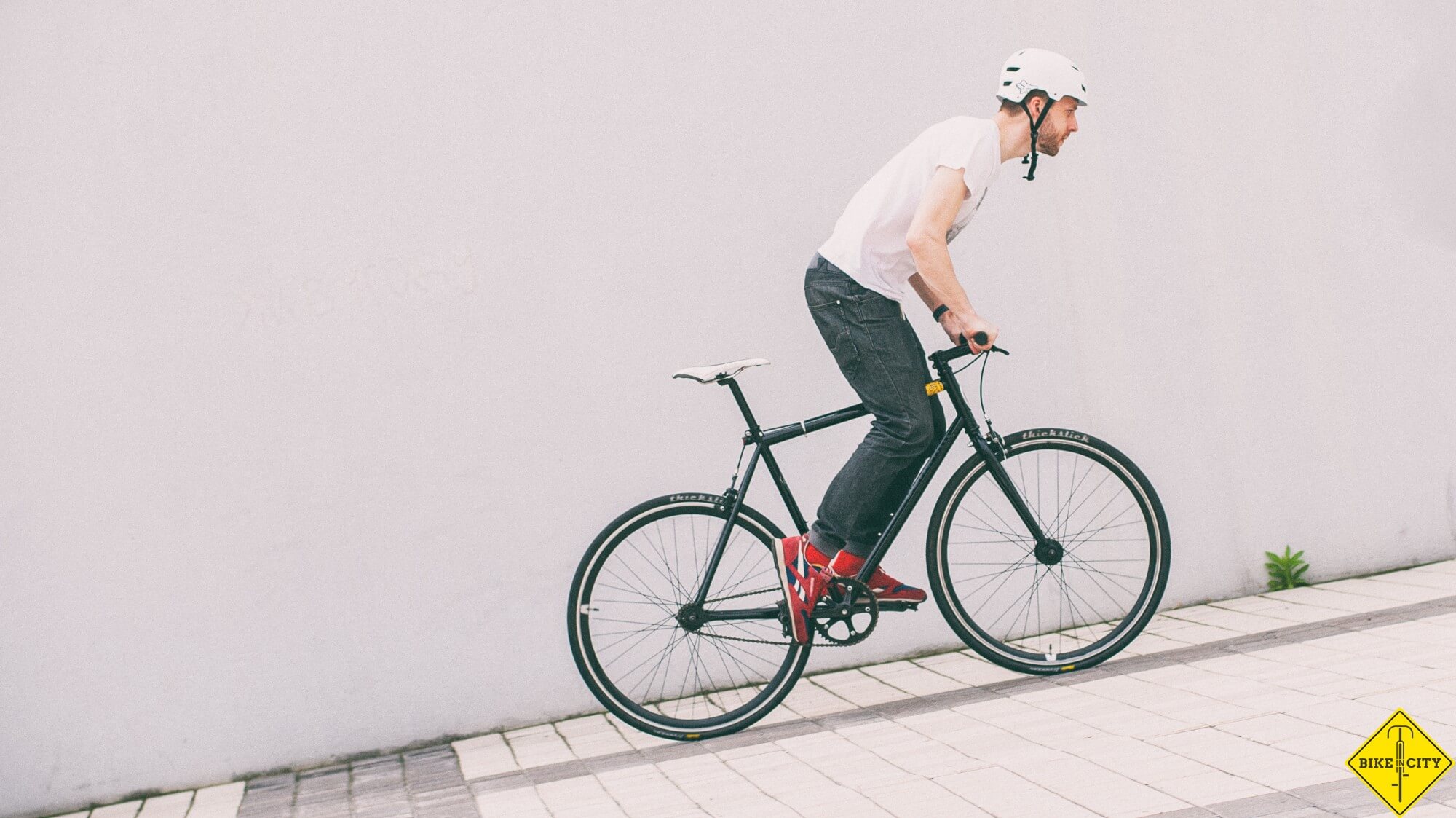
Йонас апхилит на почти стоковом Schwinn Cutter L
— Ты взял велосипед без скоростей для езды по Киеву? Псих!

Если спросить типичного украинца про оптимальный городской байк, он выберет хардтейл. За агрессивный внешний вид, готовность покорять леса и горы, надежность. Не важно, что стоит такой велосипед в хорошей комплектации немалых денег, а потенциал его город раскрыть не способен.
БУДЬ В КУРСЕ:
Любовь большей части наших сограждан именно к МТБ вполне объяснима. Именно «горные» пришли на смену Украинам и Аистам в конце 90-х. Они были уже со скоростями, имели агрессивный вид благодаря широким покрышкам, геометрии рам и пестрым расцветкам. Проблема в том, что это были не брендовые велосипеды, а преимущественно безродный китай (в народе именуемый ашанбайком). Выбирали эти не самые качественные велосипеды за относительно доступную цену, так как брендовые МТБ были не по карману простому обывателю.
Добротный «горный» байк в мой бюджет не вписывался, рисковать с б/у не хотелось, оставались ситибайки (шоссеры я даже не рассматривал). Но у доступных моделей все непросто со скоростями — либо скорость одна и зависит от размера звезд, либо используется планетарка. Сложный механизм скрывается внутри втулки заднего колеса, наружу вынесены только компактный блок, тросик и переключатель скоростей на руле. Из плюсов: надежность, переключение передач при педалировании со значительным усилием и стоя, использование обычной цепи, цена. Минусы тоже есть — планетарка тяжелая и крадет мощность.
_____


Та самая «планетарка» или вернее планетарная втулка — внутри и снаружи
Терять в эффективности педалирования (поговаривают, до 30%) не хотелось, переплачивать за лишний механизм тоже, потому договорился о тест-драйве Schwinn Speedster с трехступенчатой планетаркой и, наверное, лучшего по соотношению цена/качество синглспида Schwinn Racer. Тестовым полигоном стала Дегтяревская. Подъем там достаточный, чтобы оценить сложность киевских апхилов на базовой швиновской паре звезд 46/18, а заодно понять целесообразность наличия планетарки:

Горка далась Racer даже легче, чем я надеялся, заодно по дороге испытал сингл на коротких крутых подъемах—сложно, но ехать можно. Speedster выиграл при ускорении на спуске, а нижняя передача мне показалась лишней. Потому для себя выбрал «классику» из двух звезд и одной скорости.
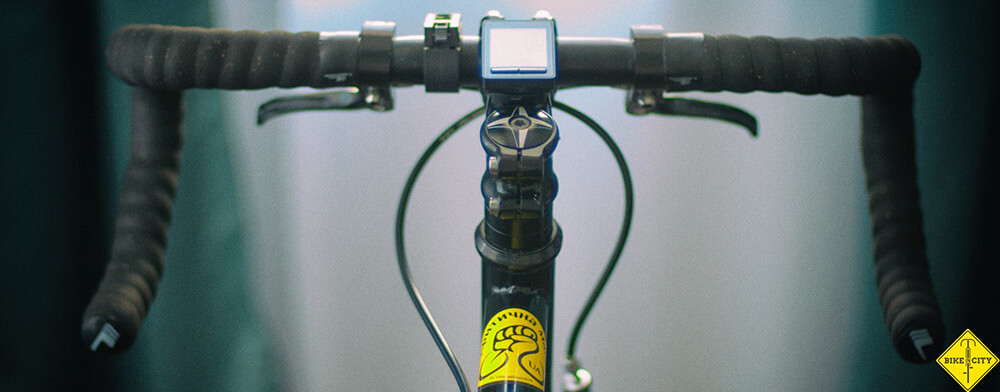 Совершенно намеренная реклама сообщества Critical Mass Ukraine
Совершенно намеренная реклама сообщества Critical Mass Ukraine
Уже сейчас, накатав более 1000 км по Киеву на синглспиде, могу ответственно утверждать — без передач даже в гористом городе можно спокойно обходиться. Но только при условии, что звездная пара обеспечивает разумный баланс тяги/скорости. У велосипедов Schwinn с этим все хорошо. Дважды заезжал на Андреевский спуск, где не только серьезный подъем, но и крайне недружелюбное для сликов покрытие. Гончара, Парковая, Льва Толстого и Владимирский апхилятся только так. Тяжко-парко, но нет острого желания слезть с байка и пройтись.
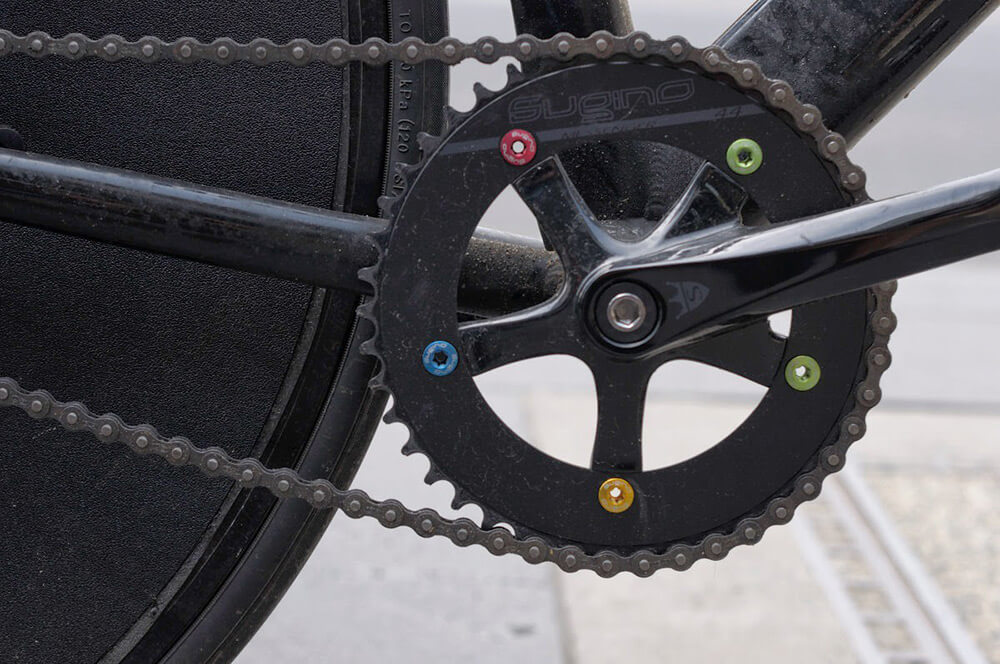

И это притом, что ездить по 12 км на работу и домой я начал вообще без подготовки.
Парень в нормальной физической форме на сингле со звездами 46/18 может осилить 99% подъемов в Киеве. Если не все 100%
Правда про Schwinn Cutter
 Богдан на своем модифицированном Schwinn Cutter M
Богдан на своем модифицированном Schwinn Cutter M
Ок, синглспид можно брать. Но какой? Я выбирал между новыми и доступными в магазинах города моделями, потому список получился коротким:
- Schwinn Racer
- Pure Fix
- Schwinn Cutter
Schwinn Racer самый доступный (
8000 грн, сейчас можно купить за 5200 грн) и классно выглядит: матовый черный с голубыми дисками (велосипед доступен так же в другой, красно-золотистой расцветке, которая, на мой взгляд, существенно уступает первому варианту). Рама стальная, с хорошей для города геометрией. Racer имеет ряд особенностей, главная из них — ножной задний тормоз, это создает немного другую модель поведения на дороге. Привыкнуть можно очень быстро, но я люблю больше ручные тормоза. Также на каттере чуть лучше втулки, передний тормоз, грипсы и подседел. Руль, кстати, более узкий, удобный именно на Рейсере. За свои деньги Racer идеален.
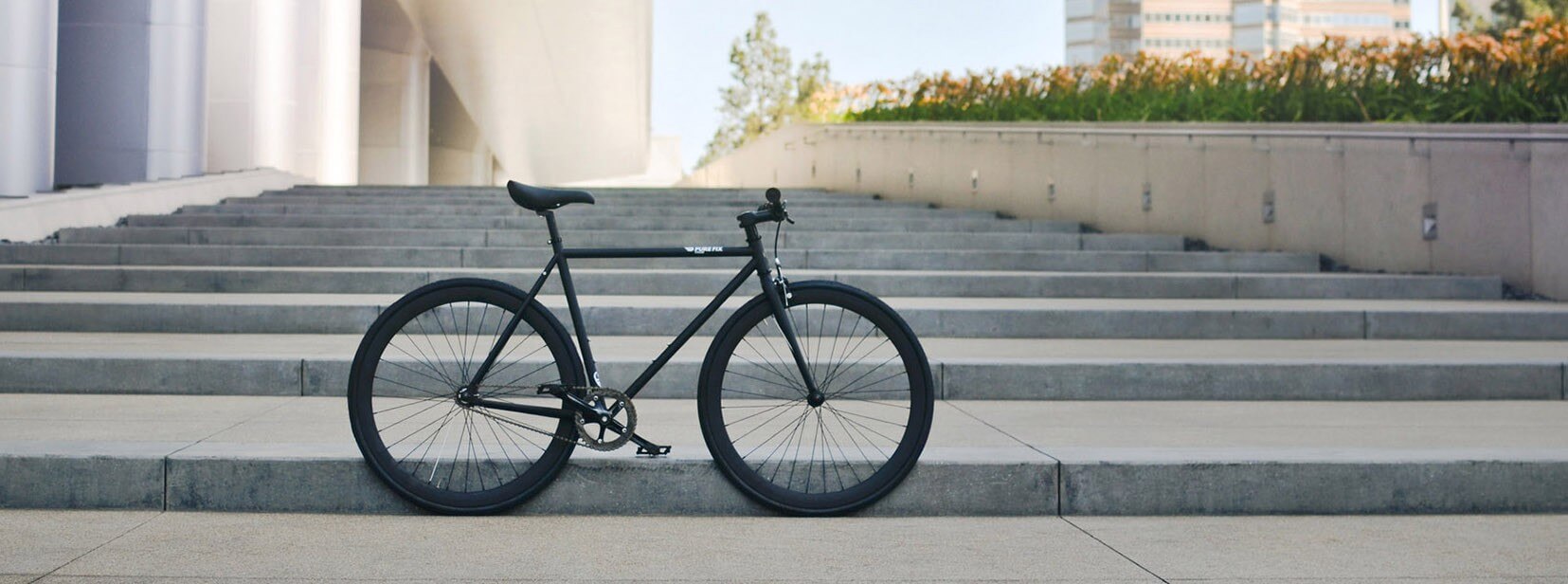 Pure Fix
Pure Fix
Pure Fix дороже на
2000 грн (10 тысяч), но доступен в очень классных цветовых комбинациях. Он легче на пару кило за счет алюминиевой рамы, имеет втулку флип-флоп, примерно того же уровня обвес. Ободной тормоз в комплекте один, все же байк предполагается использовать с фикс звездой, а еще самая доступная версия (во всяком случае у нас в стране) комплектуется покрышками уровня Racer. Рама этих велосипедов несколько отличается по геометрии—у них отсутствует слопинг (наклонная верхняя труба), что несколько снижает комфорт использования именно в качестве городского. PureFix мы обязательно раздобудем на обзор, это очень интересные велосипеды.
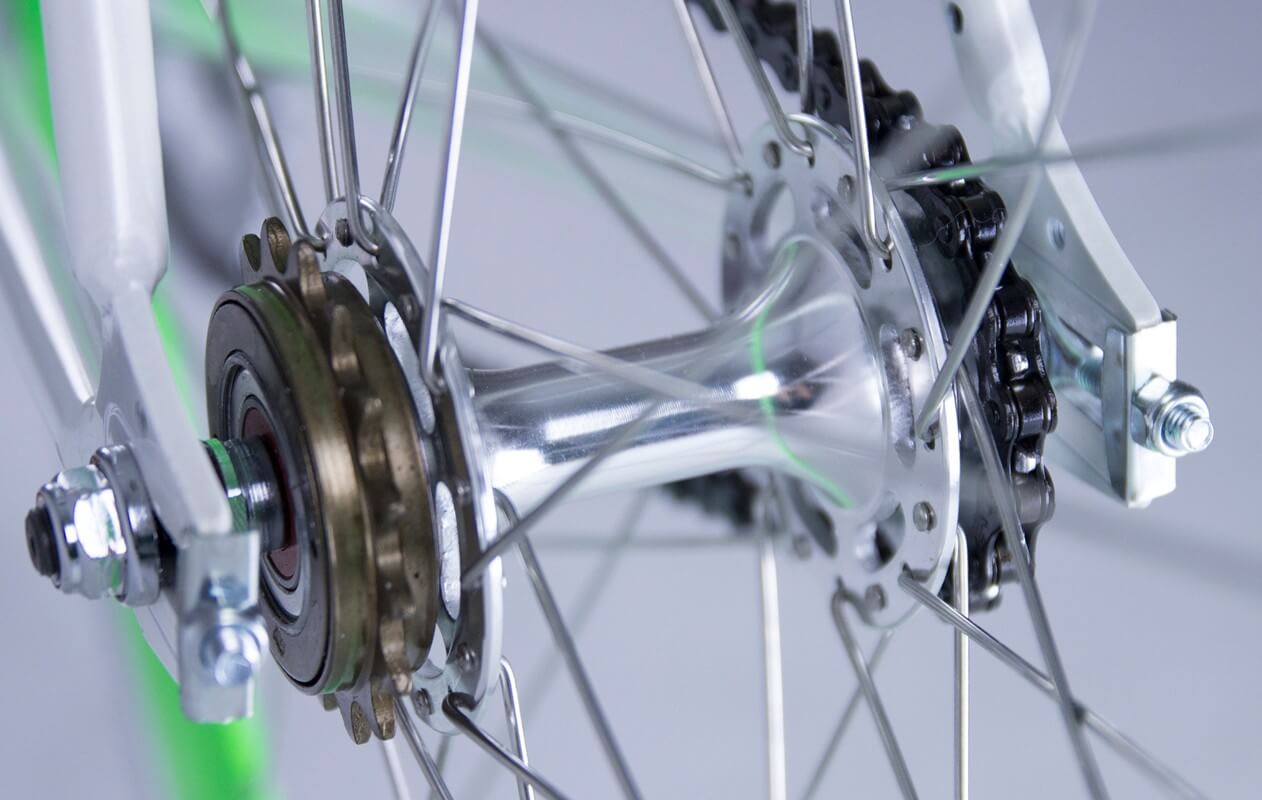 Втулка флип-флоп (Flip-Flop): фиксированная звезда с одной стороны и фривил (Freeweel) с другой
Втулка флип-флоп (Flip-Flop): фиксированная звезда с одной стороны и фривил (Freeweel) с другой
Schwinn Cutter примерно на 1000 грн дороже Pure Fix. У него аналогичная Racer стальная рама, флип-флоп втулка с фривилом (педали крутятся назад), два ободных тормоза и просто отличные покрышки Freedom Thickslick. Когда покупал, обещали более качественный и долговечный обвес, чем в Racer, но на деле что тут, что там самые простые комплектующие. Что вроде бы плохо, но не совсем. Cutter чуть практичнее Racer за счет задней втулки и пары ручных тормозов.
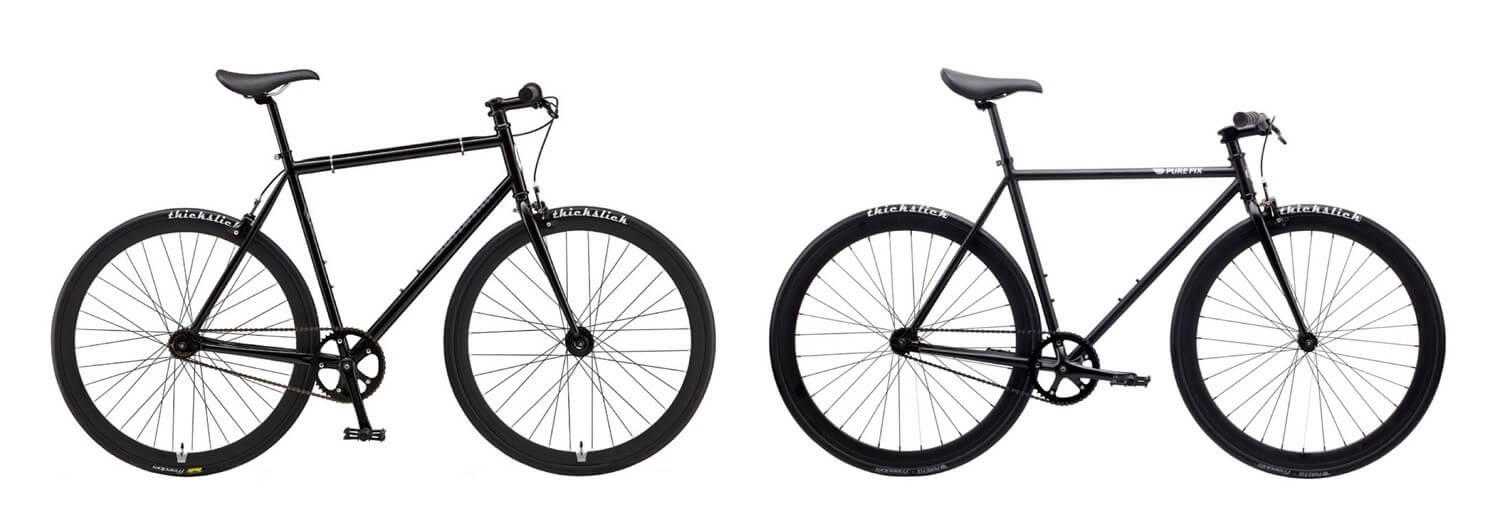
Schwinn Cutter слева, PureFix Juliet спрва — у этих моделей разные по высоте рулевые стаканы и кареточные узлы, отличается длина задних перьев. Всего миллиметр разницы в углах и размерах влияет на ездовые качетсва велосипеда, комфорт и управляемость. Какая геометрия удобнее, каждый решает сам. Но определенно нам нужно взять PureFix на лонг-тест!
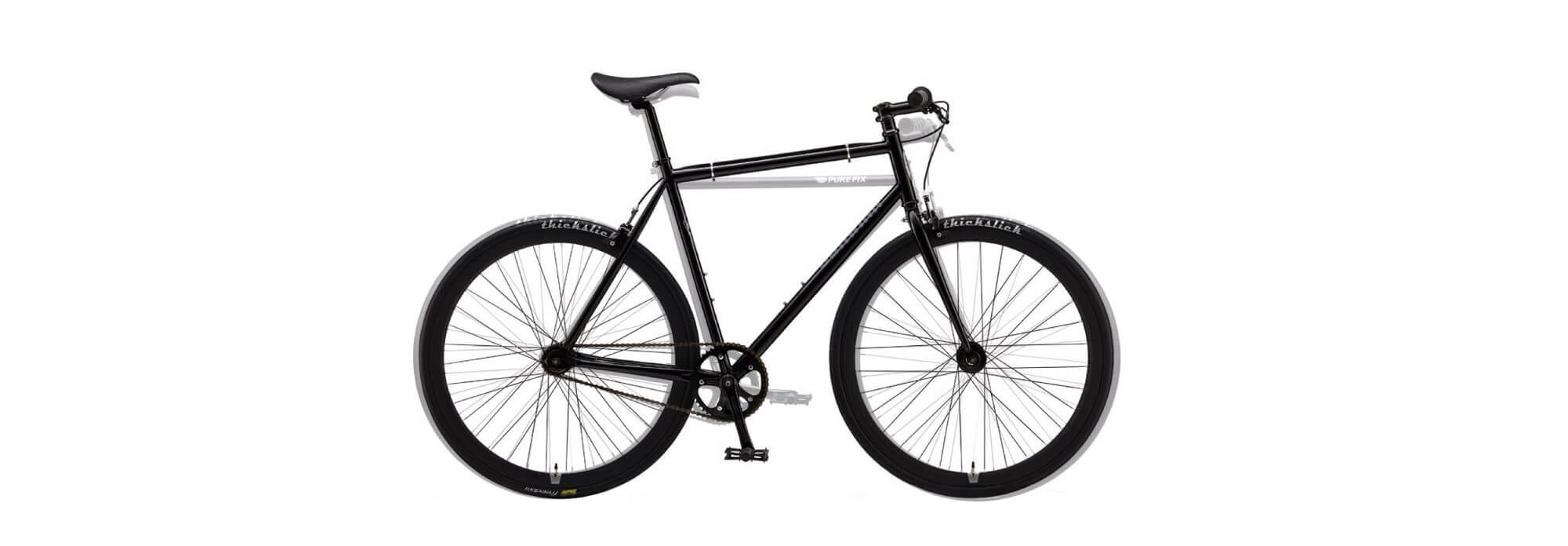
Я выбрал Cutter. За агрессивный дизайн, практичную сталь, чуть ли не вечные слики, два тормоза в паре с фривилом. А еще потому, что удалось получить неплохую скидку. В принципе, мог взять Racer—получил бы тоже неплохой экспириенс.
Сингл — это не велосипед для продвинутых, на нем сможет ездить любой независимо от подготовки и мастерства. Жена Богдана Atris на Schwinn Racer каждый день катает на работу, а Roman Sabodash взял его в качестве первого и единственного велосипеда. Оба счастливы.
Характеристики
Оценивает «железо» Богдан. Популярным языком, но с обязательной в таком случае терминологией.
Если подходить к велосипеду как к набору компонентов, то у Cutter есть свои особенности. Для начала я опишу стоковую комплектацию, а потом расскажу, что я уже поменял и что поменяю в будущем.
 Cutter после модификаций
Cutter после модификаций
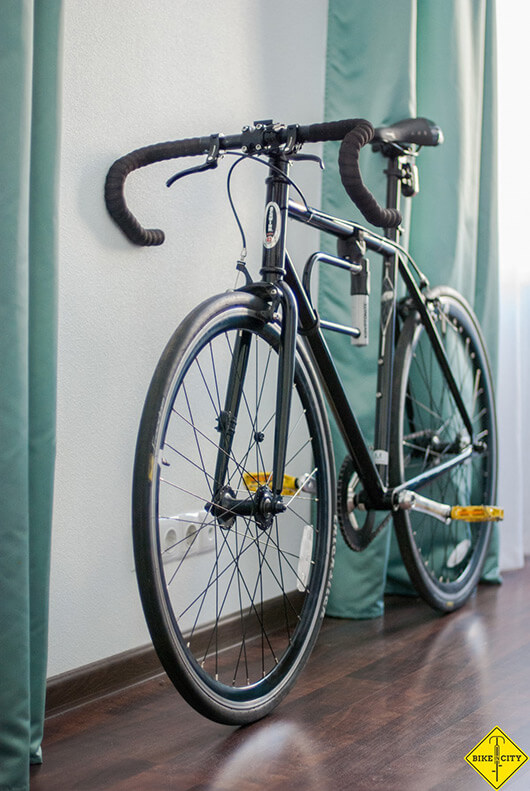
Начнем с фреймсета (рама+вилка). Материал — обычная Hi-Ten сталь, это НЕ хромолевая рама. Потому вес чуть выше, чем хотелось бы, и нет ожидаемой податливости Cro-Mo. Но все же рама лучше алюминиевой поглощает мелкие неровности и немного пружинит, устаешь на ней меньше. Вилка сделана из такой же стали, ничего особенного, за счет скругленного профиля выглядит приятно и гармонирует с рамой. Дропауты на задних перьях прямые с хорошим диапазоном натяжения цепи, это плюс. Обязательно нужно упомянуть о пожизненной гарантии на эти рамы. Производятся они еще с 1960-х, сам Элвис на такой гонял.
Рулевая стандарта 1 1/8″, безрезьбовая, но довольно плохонькая. Проживет скорее всего недолго. Я жду этого момента и поменяю ее на что-то поприличнее, благо под этот стандарт отыскать рулевую не проблема.
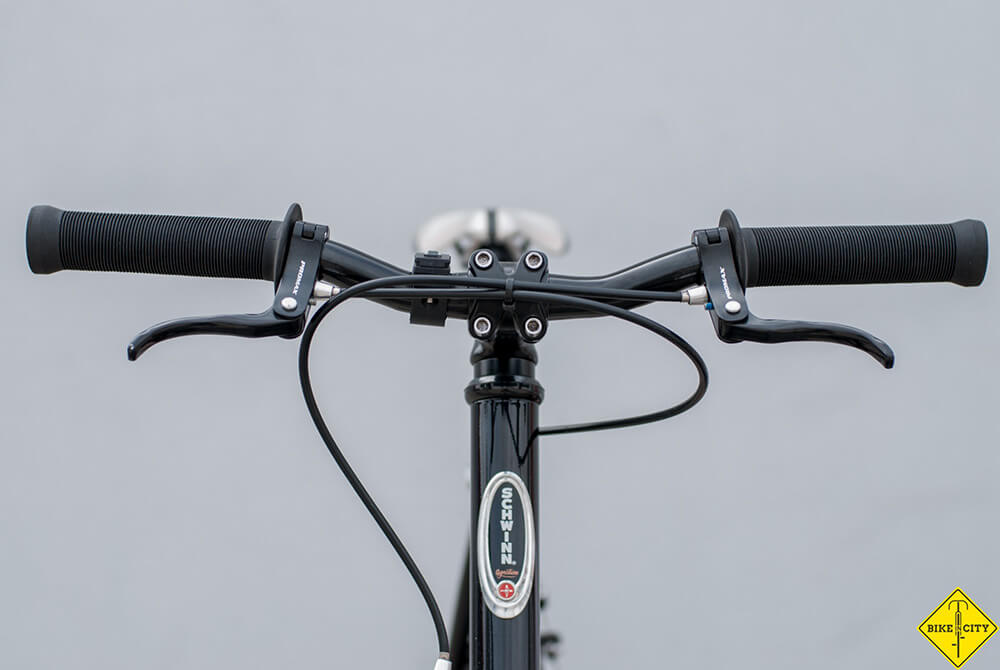
Руль в стоке — 600 мм райзер с диаметром 25.4, дешевый, но крепкий. Ручки тормозов отлично передают усилие, на скорости колесо полностью блокируется двумя-тремя пальцами. Стандартные грипсы очень понравились, позволяют ездить без перчаток, а массивные концевики страхуют, когда прислоняешь велосипед к разным поверхностям. Замечание от Yonas: «гарды» грипс трут руку даже в перчатках, мягкость ухудшает хват — нужно менять.
Вынос самый обычный, на 4 болта.
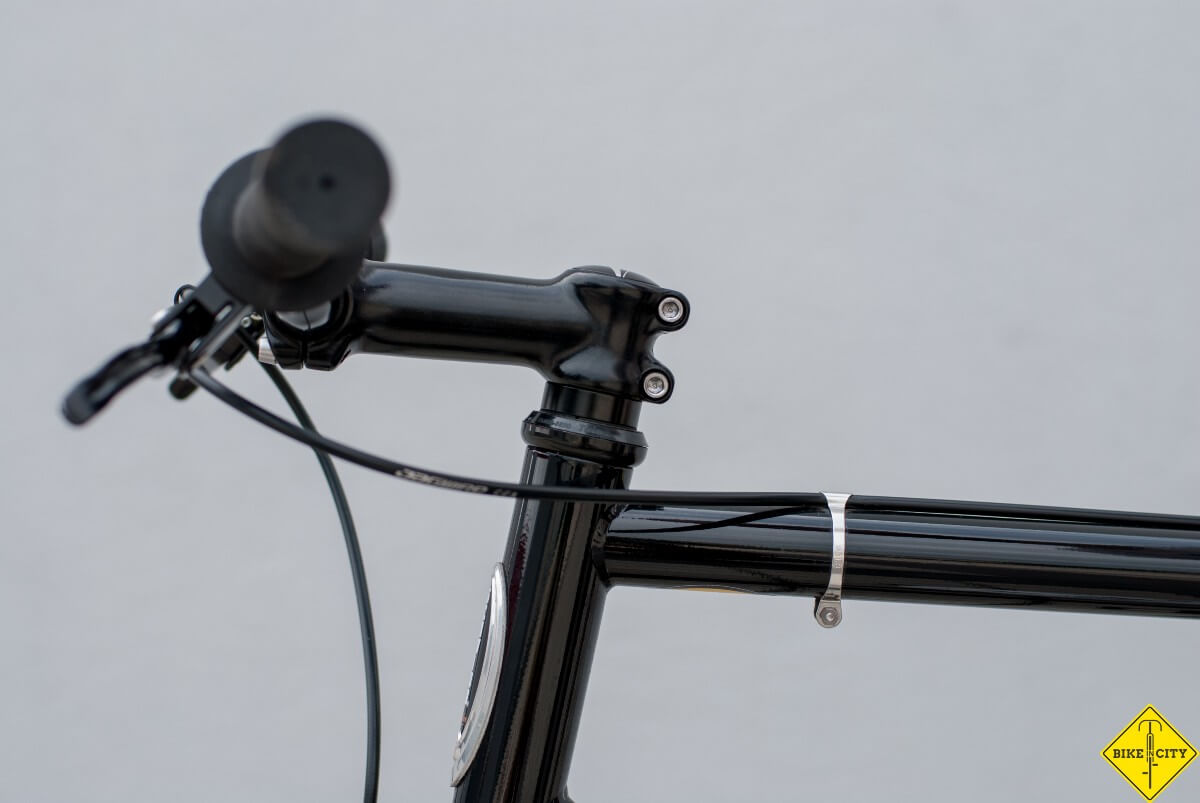 Йонас укоротил руль, подрезал шток вилки, убрал два проставочных кольца и перевернул вынос.
Йонас укоротил руль, подрезал шток вилки, убрал два проставочных кольца и перевернул вынос. 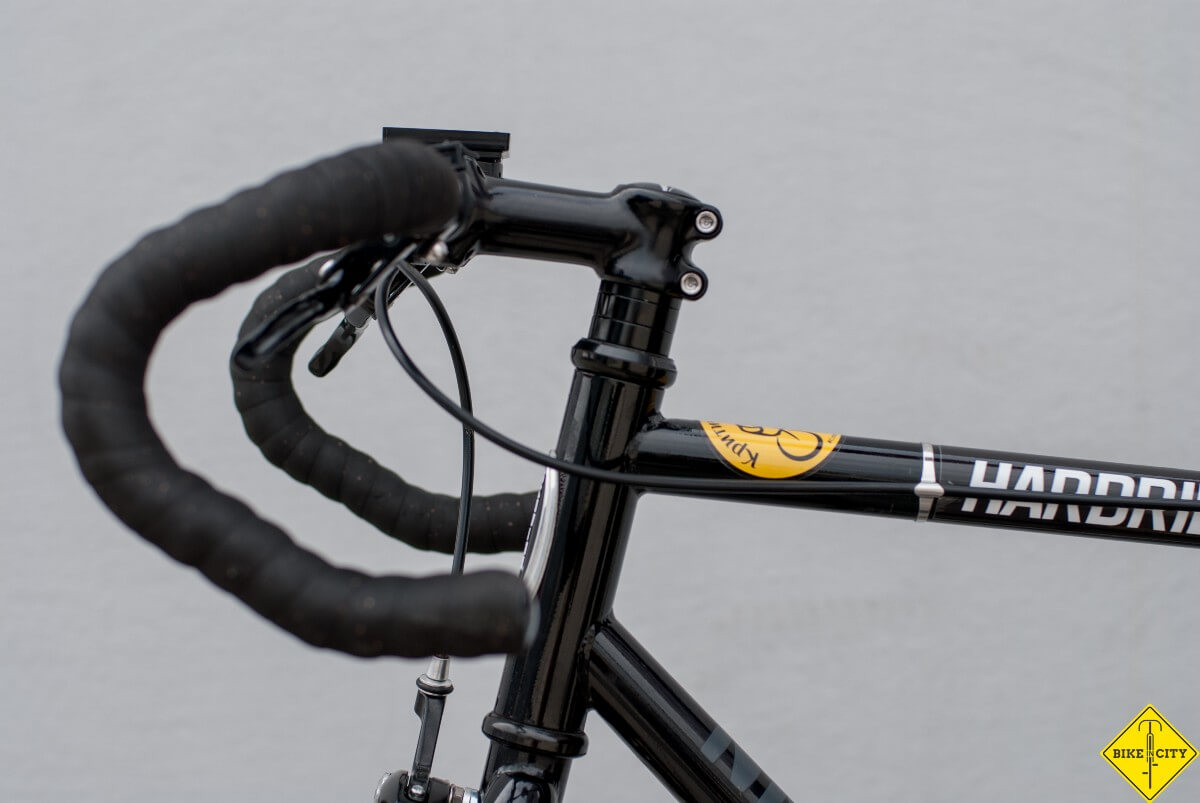 Богдан поставил баран и перевернул вынос.
Богдан поставил баран и перевернул вынос.
Подседел с офсетом, также диаметром 25.4 мм, 30 см в длину. Крепление седла одноболтовое. Все эти детали распространенных стандартов, что упрощает их замену. При этом их качество позволяет долго беспроблемно катать, если нет желания искать свой сетап. Из приятного — зажим подседела на шестигранниках. Смотрится аккуратно и не так просто скрутить седло, как при использовании эксцентрика.
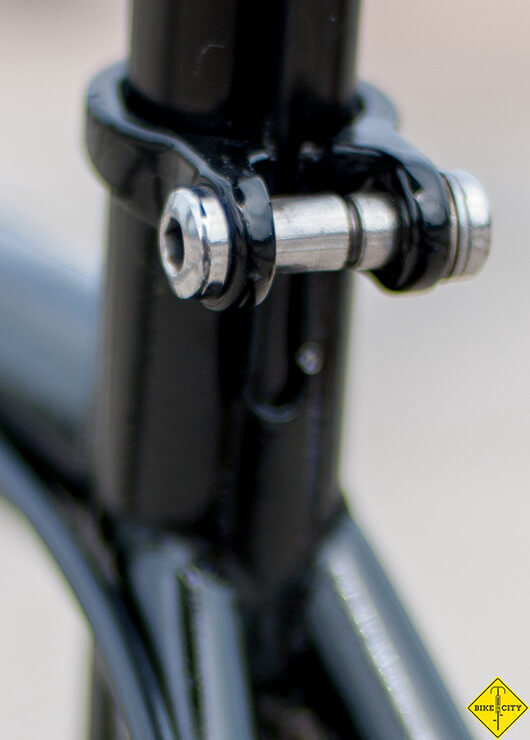
Седло. Боль. Мрак. Серьезно, ездить долго на комплектном я не смог. Его специфическая форма довольно сильно пережимает все, что можно пережать. Оно жесткое и тяжелое. Хоть выглядит неплохо. Стоит отметить, что 5-я точка у всех разная, моей жене данное седло понравилось, забрала его на свой Racer.
Не нужно делать из велосипеда фетиш. Ценность Cutter в его невысокой стоимости и сбалансированности
Привод. В стоке стоит алюминиевая система под квадрат Prowheel на 46 зубьев ведущей звезды и с полыми шатунами. Выглядит неплохо, весит немного, вполне себе рабочая лошадка (про нюанс расскажу чуть ниже). Каретка отвратительная. Она картриджная и я не понимаю, почему ее сюда поставили, экономии никакой. Под хорошим ездоком умереть должна почти мгновенно. Очень рекомендована замена прямо в магазине на что-то человеческое на пром-подшипниках.
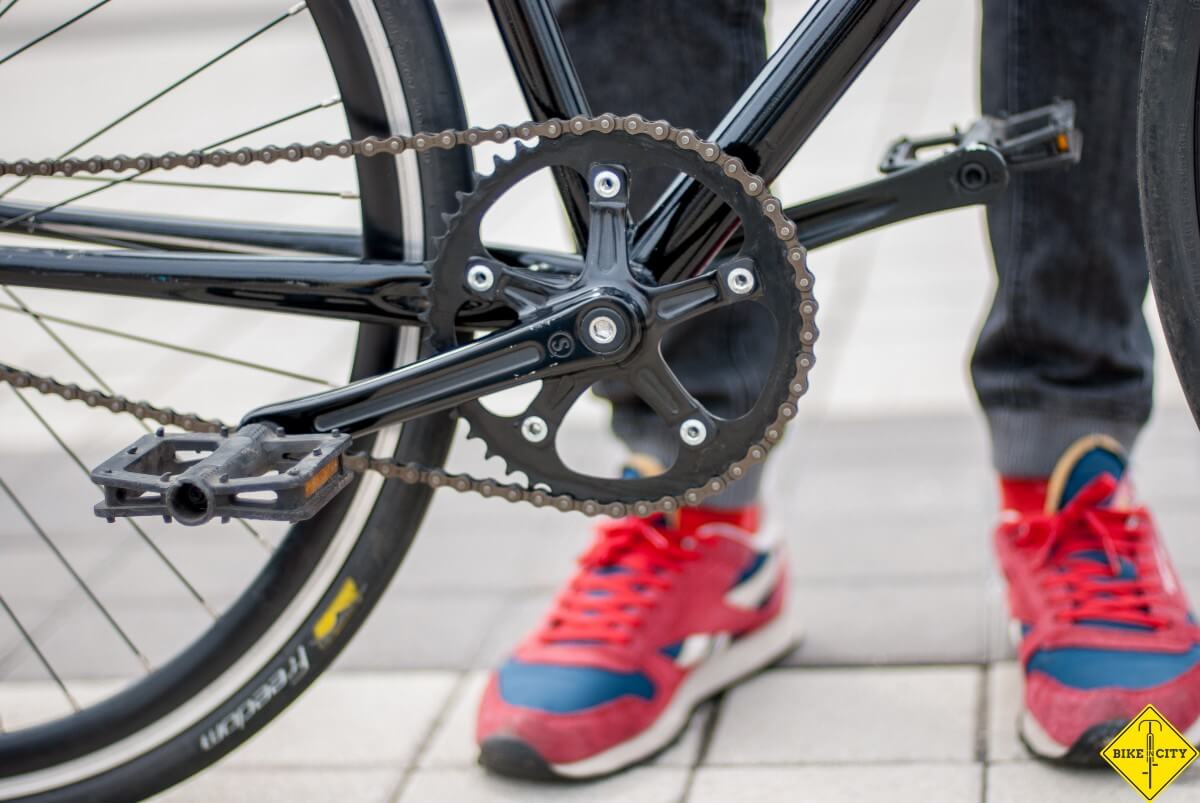
Сзади стоит обычный китайский фривилл на 18 зубьев ведомой звезды. Как и все фривиллы, он периодически щелкает при езде, немного ходит из стороны в сторону и ведет себя кое-как. Но едет и альтернативы не имеет, так что я смирился. Замечание Yonas: фривил не щелкает, а именно «стучит», причем большую часть времени. Его хорошо слышно при неспешной езде по свободной дороге, в трафике звук не так заметен. Стук сперва дико бесит, но потом и правда привыкаешь.
Цепь — KMC начального уровня, пробежала у меня около тысячи, растяжения не видно. После смерти будет заменена на красивую сингловую.
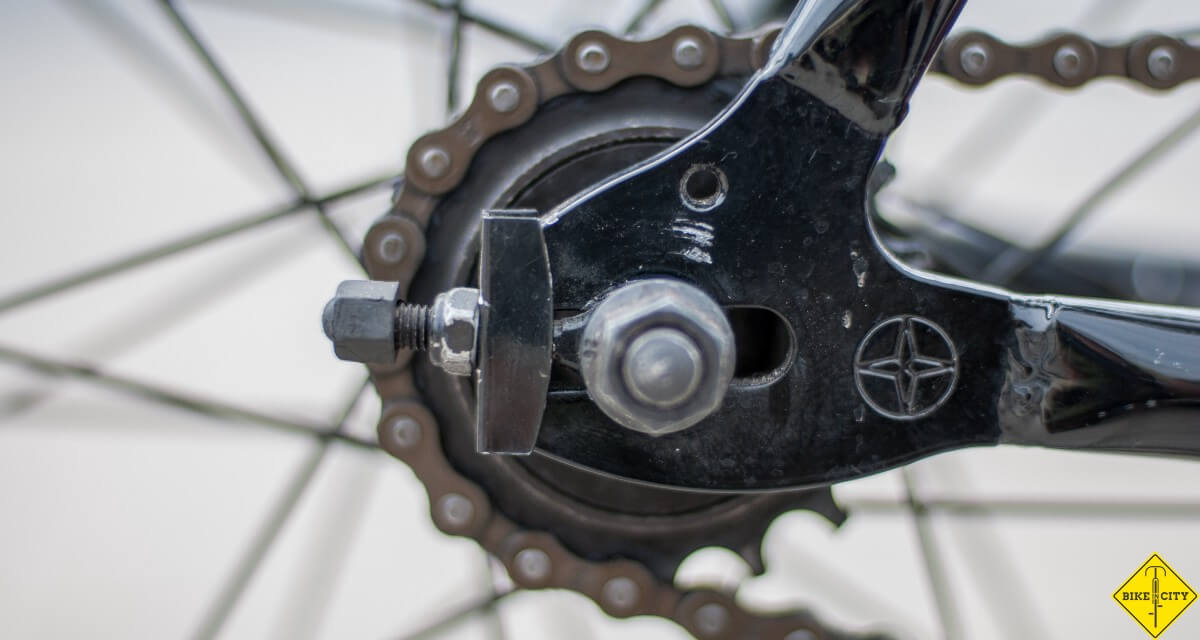
Колеса, вот тут много приятного. Обода среднего профиля, окрашены в черный. Они красивые. Также конструкция делает их крепкими и устойчивыми к продольным ударам (ямы, бровки, мелкие препятствия), но есть опасение касательно боковых—могут деформироваться. Спицы стальные и тяжелые. Вообще колеса не из легких, что для повседневного велосипеда не является большой проблемой, лишь бы не досаждали поломками. Втулки конусные, вполне надежные. Из характерного — высокие фланцы, по-трековому. Безопасности добавляют гайки вместо эксцентриков, так просто колесо не открутишь. Мне колеса нравятся.
Отдельно необходимо отметить совершенно чумовые покрышки Freedom ThickSlick. Выглядят потрясно, толстые, отлично идут в контролируемый занос, ходят долго, пробиваются нечасто. Сплошная любовь! Из недостатков — тяжеловаты и дорогие.

Такие дырки остаются после выковыривания проволоки и стекла, но при этом камера целая. Еще не снимке хорошо виден износ. Эта резина прошла более 1000 км, Slimp при каждом удобном случае уходит в занос
МИР ПРОФИ
Отмечу, что именно покрышки шириной 28 мм последние два-три года начали использовать профессиональные гонщики на сложных покрытиях типа Тура Фландрии или Париж-Рубэ. При меньшем давлении (5–6 атмосфер) такие покрышки обеспечивают отличный накат, при этом более комфортны на брусчатке и разбитых дорогах.
_____
Тормоза — вот тут вообще зачет! Хорошие шосейные клещи, качественные рубашки тросов от Jagwire и очень приятные тормозные ручки. Ну и еще трушный внешний вид. Из нюансов «под себя» — после износа поставлю колодки получше, стоковые не так хорошо хватают, как хотелось бы с учетом моего веса (95 кг). Более легкому ездоку останавливающей силы должно хватать.
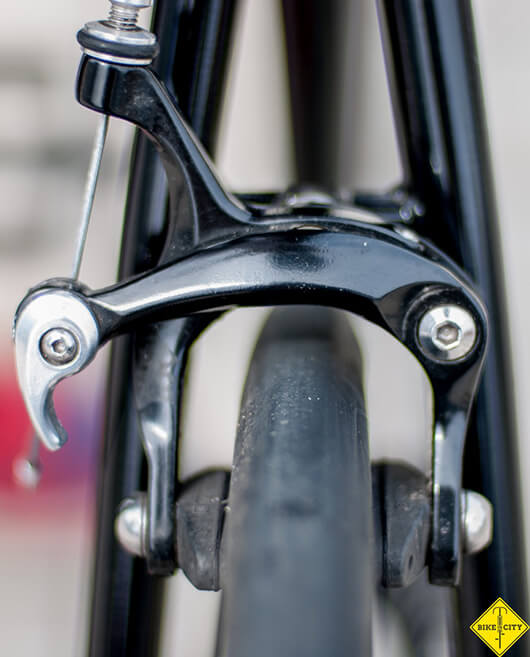
Педали. Пластиковое убожество, которое гнется даже рукой, без держака. Менять однозначно. Замечание Йонаса: на фото ниже именно мои педали с пробегом over 1000 км. Моего небольшого веса в 70 кг не хватило, чтобы погнуть оси, довольно быстро появился небольшой люфт, пластиковые шипы слизывались один за другим. Но есть и светлые стороны: педали большие и… пожалуй, на этом все.

Что имеем в сухом остатке? Для цены велосипеда компоненты подобраны органично, если не придираться, то можно ездить долго и не испытывать никакого дискомфорта. Но я решил заморочиться.
Первое, что было заменено — это система. Дело вот в чем. Несмотря на то, что она довольно неплохая, при сборке велосипеда левый шатун немного недозатянули. И я буквально за два дня активной езды его разболтал и напрочь слизал квадрат. Тут стоит сделать реверанс в сторону Велопланеты, они признали это гарантийным случаем и поставили мне новую систему. НО! Так как аналогичной системы в наличии не было, мой Cutter получил новехонькую Sturmey Archer, которая на голову выше стоковой. Так как квадрат на каретке тоже слизался, она также подлежала замене. Я доплатил 130 гривен и получил практически вечную каретку на промах.

В тот же момент ужасные пластиковые педали были надежно спрятаны в шкафу, а их место заняли магниевые гравити-топталки на промах и с шипами. Ногу держат отлично, широкие, удобные, надежные и неприхотливые. Почему не контакты или туклипсы? Велосипедом я езжу на работу, в различной обуви. Переобуваться нет охоты, а туклипсы могут царапать туфли. В моем случае хорошие топталки — оптимальный выбор.
Третьим под замену пошло седло. Я всегда был фанатом марки FI’ZI:K, поэтому когда подвернулось с хорошей скидкой Rondine Life с хромолевыми рейками, не смог пройти мимо. Покупка себя оправдала на 100%. Из последних достижений: на этом седле была проехана сотка и ничего не затекло (трек этой поездки, Runtastic продолжал работать на остановках, реальная средняя скорость была 28,7 км/ч).
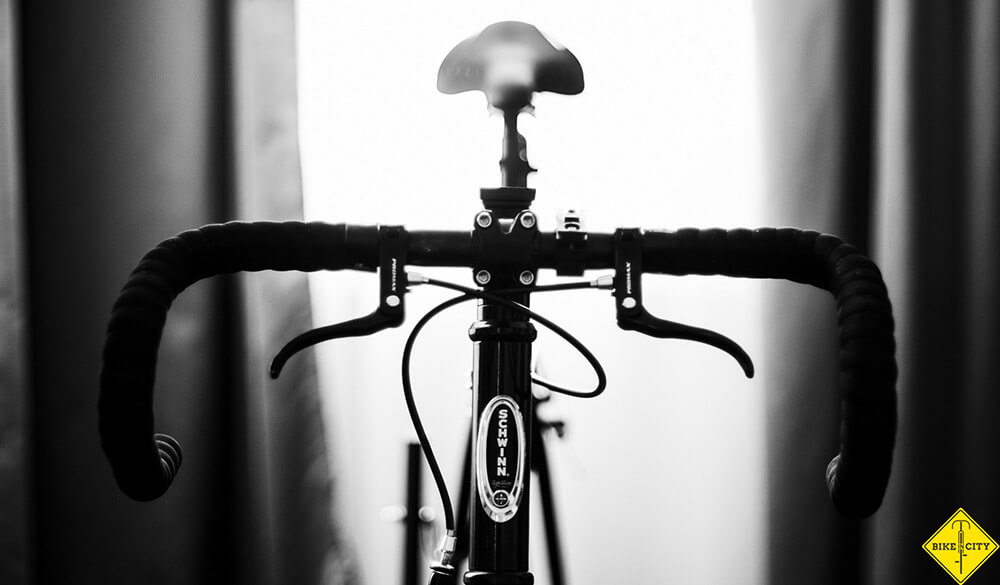
Комплектный руль мне казался слишком широким (Йонас его укоротил на 14 сантиметров) и недостаточно удобным, плюс высоковатым. Поэтому был заменен на шоссейный баран с мягкой обмоткой. Тормозные ручки сразу на него не стали, пришлось растачивать (благо есть очень хороший знакомый механик). Для придания посадке еще более спортивного вида был перевернут вынос. На данный момент все нравится и сижу на байке максимально комфортно.
Следующим апгрейдом станут хорошие тормозные колодки—хочется увеличения останавливающей силы. Также приобрету красивую сингловую цепь, по типу KMC K810SL. Ну и рулевая, со временем, тоже пойдет под замену.
А если помечтать? Запросто! Можно поставить карбоновую вилку, карбоновый руль и подседел, стоит все это сейчас вменяемых денег. Потом подыскать неплохие колеса. Все это позволит сделать Каттер легче, но не имеет практического смысла, так как убьет концепцию «неприхотливого велосипеда на каждый день».
Передаю слово обратно Йонасу.
In Use (over 1000 km)
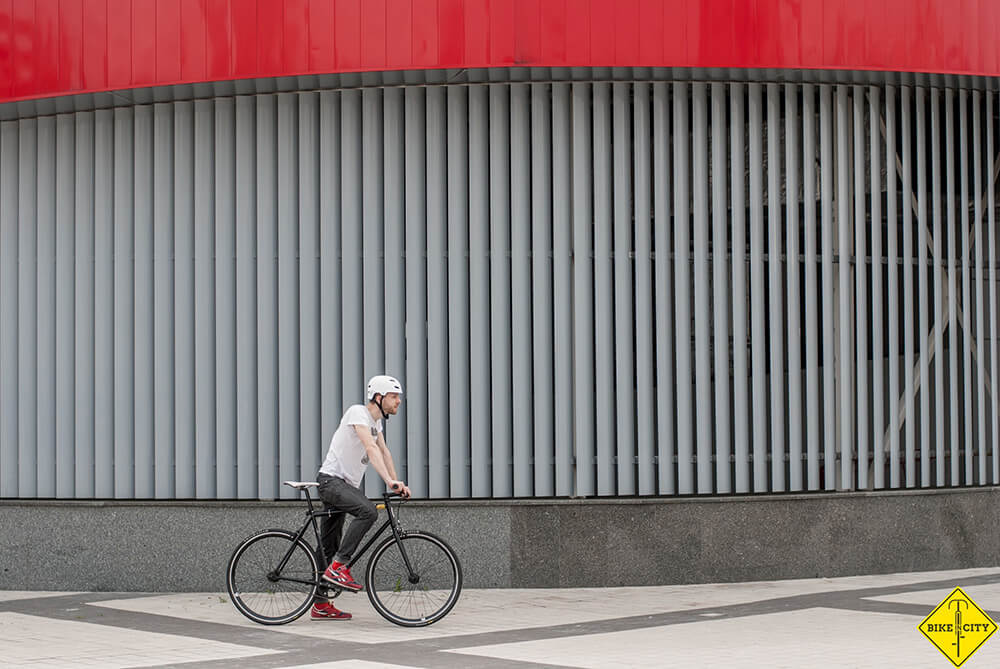
С каттером мы сдружились не сразу. Первый же заезд из магазина домой с расстоянием в 15 км расслабил левый шатун—появился заметный люфт. Пришлось искать поближе к дому сервис и проводить техобслуживание. Собирая велосипед, мастера магазина недостаточно хорошо зажали механизм. Заодно за 200 грн установил картридж на промах и оценил мизерную стоимость расходных комплектующих в сравнении с «серьезными» байками.
Разобравшись с одной проблемой, обнаружил другую—при кручении педалей слышен стук. Помучал сервис магазина, мастера которого были не в курсе о такой примечательной особенности фривилов, не нашел решения и смирился.
Потеряв более двух недель на описанные «нюансы», взялся наверстывать упущенное. У велосипеда отличная динамика. По ровной дороге можно за пару секунд набирать 20–25 км/ч, что очень выручает на светофорах. Скорость максимальная при стоковых звездах по ровному в районе 42–45 км/ч, но тут все зависит от допустимого для вас каденса. Покрышки Freedom Thickslick классно держат асфальт и достойно справляются с сухой брусчаткой. В дождь риск заноса возрастает, но при грамотном управлении и аккуратной езде по мокрому покрытию чувствуешь себя уверенно. Замечание Slimp: выезжать в дождь на плитку сродни самоубийству. Срывает переднее, заднее заносит. Однажды у меня вышло сделать разворот на 360 градусов, но было очень стремно.
Отдельной похвалы заслуживает стальная рама. Да, она тяжелая, зато гасит вибрацию! При хорошо накачанных (5.6 атмосфер) шинах можно без проблем проскакивать Европейскую площадь и даже нестись по Андреевскому спуску вниз. Тот же финт на алюминиевой раме—настоящая мука. Вес велосипеда выше, чем хотелось бы—12–13 килограмм в зависимости от навески. Но когда нужно, крепкий парень вроде меня может и высоко поднять, и перенести.
 Страдания на лице от того, что Богдан все не мог сделать идеальный кадр и мне пришлось минуты три держать на вытянутых руках стальной вел
Страдания на лице от того, что Богдан все не мог сделать идеальный кадр и мне пришлось минуты три держать на вытянутых руках стальной вел
Через пару недель регулярных заездов #BikeToWork и нескольких найтрайдов у меня начал формироваться список желательных модификаций. Кое-что уже реализовал, остальное в планах.
Вопросы к базовой комплектации:
- Седло очень на любителя. В эстетике фиксов, но совершенно не эргономичное. Решение: поставил потрепанное, но удобное седло Selle Italia SLR XC. Сейчас испытываю барское Brooks B17.
- Руль неоправданно широкий. 600 мм уместны в кросс-кантри, но в городе сильно усложняют маневрирование между машинами. Решение: отпилил по 7 см с каждой стороны.
- Посадка вертикальная. Это неплохо если катаешь по 5 км в прогулочном темпе, но носиться между автомобилями при средней скорости 25–27 км/ч неудобно. Решение: подрезал рулевую колонку, снял два кольца, перевернул и опустил вынос.
- Педали одноразовые. Однозначно надо менять.
- Грипсы посредственные. В описаниях модели велосипеда их подают как особо мягкие и комфортные, но мне даже в перчатках неудобно. Кроме того, при крепком хвате слегка прокручиваются и могут чуть сползать.
Выбранные мною опции:
- Нужны крылья. С мокрой спиной кататься ни капли не здорово.
- Заменить руль райзер на балхорн (возможно, баран). Сейчас очень не хватает возможности аэродинамически сложиться во время езды по длинному ровному участку дороги. Ручки тормозов при этом можно чуть сместить к выносу, так что в удобстве вертикальной посадки потери не будет.
- Поставить педали с туклипсами или футстрапами. Хочется более эффективного педалирования, когда можно не только давить на педаль, но и вытягивать ее наверх.
- Немного увеличить значение передней звезды (или уменьшить задней). Надеюсь, окрепшие ноги вытянут основные апхилы и сохранят динамику, а на ровных участках будет возможность ехать быстрее.
Особое мнение Богдана
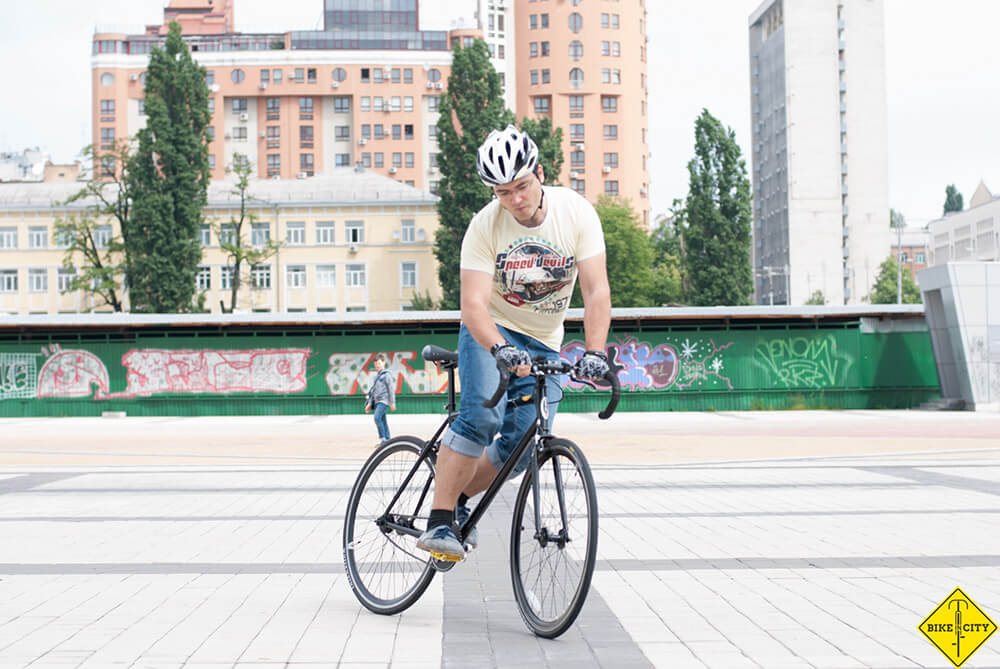
Откатав первую тысячу, могу сказать, что Cutter для меня — это идеальный городской велосипед. Имея еще и найнер, пришел к выводу, что на сингле в Киеве намного удобнее. Апхилы не представляют вообще никакой проблемы, только вот брусчатку не люблю. Шоссейный баран позволяет менять хват и аэродинамически складываться, взятая за 3:35 сотня километров показала полное соответствие комплита моим требованиям и возможностям. Но переодически приходит идея поставить назад звезду не на 18 зубьев, а на 16. Нужно испытывать, но есть опасение, что на некоторые подъемы типа Андреевского спуска уже не заеду.
Касательно скорости. Абсолютно комфортной на Каттере является скорость около 25 км/ч. Это в повседневной одежде. В режиме “спорт” легко держать среднюю 30–32 км/ч. Максимум, до которого я могу разогнать велосипед на ровном асфальте — 43 км/ч, кручу педали при этом я около 140–150 оборотов в минуту и долго такой темп держать мне не позволяют ни физическая форма, ни технические навыки. На спуске велосипед хорошо едет до 60, потом страшновато.
Top 10 Best Single Speed and Fixed Gear Bikes of 2021

- Top 10 Best Single Speed and Fixed Gear Bikes of 2021
6KU Track Fixed Gear Bicycle
Golden Cycles Fixed Gear Bike Steel Frame
Retrospec Bicycles Mantra V2 Single Speed Fixed Gear Bicycle
Whether you are brand new to the world of bikes, or you’ve been biking for as long as you can remember, a single-speed bike may seem like a weird trend that only extreme enthusiasts would be interested in. But the truth is that single speed bikes, also called fixed gear bikes, or “fixies”, offer a really cool experience for anyone who loves to ride.
Fixed gear bikes were used in the original Tour de France, and are likely what you started with as a child who still used training wheels to get down the street. If you want to enjoy the most simplified form of biking, this trend is one to try. However, before you start searching for the best single gear bikes, it’s important to know a bit more about what fixies actually are.
Table of Contents
What is a Fixie?
A fixed-gear bike is one in which the cog is controlled only by the motion of each pedal. In all other bike models, there is a ball bearing system that allows the wheel and cog to spin independently, which will enable you to change the speed of the bike by controlling the ball bearing system with your handlebars. On a single-speed bike, however fast you pedal will determine fast the bike goes. Your pedaling directly causes the wheel to spin. The best fixed gear bikes can also be ridden backward because if you pedal backward, the wheel will rotate backward.
Why Buy a Fixie?
Now that you know what a fixie is, why would you want to own one? The biggest reason for having a single-speed bike is in the simplicity of the build. The bike will be easier to use, simpler to repair, and much lighter to ride. Because of the lightweight build and ease of riding, many people also find the fixie to be easier to maneuver.These are just a few of the reasons that many consider a single-speed bike to be the best option you can choose.
Fixies also allow you to choose your braking method. You can engage the freewheel for the standard braking method, or remove the front brakes or rear brakes and simply resist on the pedals or skid-stop to brake. It is entirely up to you how you want to ride, something that biking enthusiasts will appreciate about these highly customizable bikes.
Fixed gear bikes are usually for commuting rather than racing, although you can find hybrid fixies that work for both. As a commuter bicycle, a fixed gear bike is often valued because it requires very little maintenance and cleaning. It’s also ideal for winter riding because you can more easily moderate your speed in the moment.
Another great reason to buy a fixie? They are cheap! These bikes are simple, and that translates into lower prices for the rider. If you are just looking for a reliable commuter bike, a single-speed will save you a lot of money.
The Best Single Speed and Fixed Gear Bikes
With all those considerations in mind, we rated the top 10 best single speed bikes on the market today. These are our favorites for riders of all skill levels, and any would make an excellent fixie for someone interested in trying out this trend. All of these bikes fall between $100 and $900, so rather than rate their price range, we’ve included notes on which bikes are affordable in the reviews below. Fixies fall in a variety of price ranges, but all tend to be much more affordable than other road bikes.
| Name | Frame | Key Feature | ||
|---|---|---|---|---|
| 6KU Track Fixed Gear Bicycle | Aluminum | Quality brake system and lean response | CHECK LATEST PRICE | |
| Golden Cycles Fixed Gear Bike Steel Frame | Steel | Flexible for many types of riding | CHECK LATEST PRICE | |
| Retrospec Bicycles Mantra V2 Single Speed Fixed Gear Bicycle | Steel | High-quality components | CHECK LATEST PRICE | |
| Critical Cycles Harper Single-Speed Fixed Gear Urban Commuter Bike | Steel | Very comfortable ride | CHECK LATEST PRICE | |
| Pure Fix Original Fixed Gear Single Speed Bicycle | Steel | Good for beginners and experienced riders alike | CHECK LATEST PRICE | |
| Critical Cycles Classic Fixed-Gear Single-Speed Track Bike | Steel | Affordable price for beginners | CHECK LATEST PRICE | |
| Vilano Rampage Fixed Gear Fixie Single Speed Road Bike | Steel | Very stable ride | CHECK LATEST PRICE | |
| Critical Cycles Classic Fixed-Gear Single-Speed Bike | Steel | Affordable price for beginners | CHECK LATEST PRICE | |
| Pure Fix Glow in the Dark Fixed Gear Single Speed Bicycle | Steel | Safety for night riding | CHECK LATEST PRICE | |
| Pure Fix Premium Fixed Gear Single Speed Bicycle | Chromoly | City-friendly riding set up | CHECK LATEST PRICE |
6KU Fixie Urban Track Bike
6KU bikes are quickly becoming an excellent option for anyone who wants to get into the best single-speeds without a huge commitment. These bikes are made with lightweight components, including aluminum frames, that make them easy for new riders and very stylish.They come in several colors, including tennis ball yellow, matte black, gloss white and black, shadow black, and crisp white.
This is the only aluminum bike on our list, but the track bike’s head-turning style and high-quality components otherwise make it neck and neck with some of the more durable bikes on our list.When receiving the bike, you will also get the tools you need for assembly and servicing the bicycle down the road. It includes riser handlebars for the best possible speed while commuting in style.
The biggest draw for the 6KU Urban fixie aluminum track bike is the brake system. It features a very responsive system that isn’t common on entry-level single-speeds, and the lean response is phenomenal.For beginners, it’s a fantastic choice since it needs minimal upkeep and maintenance. It also has a 30-day hassle-free return policy in case it doesn’t fit your needs.
The only drawbacks are the saddle and the pedals, both of which could be of higher quality. We’d recommend switching these out with better parts before long, but that one fix could easily make the 6KU a great fixed gear bike for riders of all skill levels.It doesn’t hurt that it comes at a pretty decent price point for all that it will offer you. If you don’t mind an aluminum bike, this is pretty much the best option you can choose.
- A lightweight option that comes with a full aluminum fork and aluminum frame
- Can ride in fixed gear or freewheel using the flip-flop hub
- Comes with a 30-day return policy if it doesn’t work as expected
- Some riders have experienced issues with the riser bars or pedals breaking
Golden Cycles Fixie with Deep V Rims

The Golden Cycles Fixie is another hybrid bicycle, with a flip-flop hub that allows you to shift from a traditional fixed gear ride to a single-speed freewheel. This means that you can take this bike anywhere, from streets to off-road trails. It’s as good as any of the track bikes on the market and comes in multiple sizes so you can be sure it meets your needs.
The components make for a smooth, comfortable ride for commuters, but this bike has enough meat on its bones to go uphill or through some rougher terrain. It’s also easy to customize and personalize for your specific riding needs.The flip-flop hub offers you the option to ride freewheel or fixed depending on what you prefer, while the riser bars offer convenient and easy riding.
While this bike looks really cool with the deep V rims and the color combinations available, it does lack some of the durability of other bikes on our list. Upgrading fixies are easy, but that will add to the overall cost of this bike. However, the price is right, and making upgrades later may make it the best choice for those who are on a budget.
It’s the perfect solution for a rider that wants to try a single-speed but doesn’t want to have to cart around tons of bikes to go wherever their mood may take them. It can do a little bit of everything and works as a great all-around fixie bike for someone who wants a simple option for doing whatever they love.
- Offers a high-tensile steel fully tig-welded frame and a steel fork
- Includes alloy riser bars and a Neco headset for convenience when riding
- Features a flip-flop hut with a fixed gear cog and single speed sprocket
- Some people have received products that don’t include the required tools
Retrospec Mantra V2 Urban Commuter Bike
If you’re looking for a bicycle that combines high-quality components with excellent style, the Retrospec Mantra is our top choice. It’s a great compromise between good looks and solid construction, and the lightweight frame maintains durability without sacrificing maneuverability – something that many fixies lose in exchange for better quality.It offers an UrbanComfort diamond frame, FGFS removable Velcro straps, super deep V-star rims, and a KMC chain.
This bike also combines just enough classic style with a modern appeal so that it works for all riders.There are 12 different color options available ranging from a single white and black to sky blue, hunter green, crimson, chrome and black, and more. With so many choices available, you’re sure to find the right bike to fit your own personal style. It also has the comfort you want through the high-quality frame that promises no toe overlap, bar spin clearance, and horizontal dropouts.
The only downside is that this bike only has a rear brake, but it does have the flip-flop hub along with sealed cartridge bearings on both wheels. The bike has stylish accessories on each pedal and the riser bars, but it doesn’t go too far into the realm of BMX styling to lose the fans of classic fixies.It has the tech you want, but it also has the style you may be looking for.
This may be one of the pricier options on our list, but it’s worth it for fixie enthusiasts. It also comes in plenty of colors so you can choose which style suits you best. Overall, this bike is ideal for the committed fixie fan who wants to commute or ride on paved trails. It comes in several sizes from extra small to extra-large so there’s little chance it won’t work for you.
- Single-speed, fixed gear commuted back is new and improved from 2016
- Includes Kenda Kwest commuter tires, KMC chain, VP freestyle pedals, and deep V-rims
- Includes both front brakes and rear brakes for confident, secure riding on city streets
- Some cyclists have experienced wheel issues requiring replacement
Critical Cycles Harper Fixed Gear Urban Commuter Bike

If you love the idea of a fixie, but aren’t a fan of the almost child-like styling of many of them, Critical Cycles’ Harper is the bike for you. This fixed-gear bicycle has a sleeker look, with a sophisticated color palette and silhouette.It comes in several colors, including Atlantic blue, matte black, matte graphite and orange, Retrospec sage green, Retrospec white and black, slate, and Pacific blue.
It is designed mostly for the beginner rider, but that doesn’t mean it can’t also work for an advanced rider. But for beginners, the components on this bike are ideal; it offers the most natural type of braking system, reliable construction, and a very smooth ride to keep you comfortable.It also offers a flip-flop hub so you can ride it as a single speed and fixed gear or with a freewheel.
Unfortunately, Critical Cycles missed the mark with this bike when it comes to the tires. They do tend to wear out faster than other bikes we reviewed, so you’ll be replacing them sooner. But all the other components are of exceptional quality, and you can’t beat this bike for comfort and style.It also has a reasonable price which can’t be forgotten when budget matters to most people.
It’s worth changing out what components you don’t like for your preference in order to get the Harper frame.The bike is very safe for beginners and has components to optimize your ride, whether you’re commuting or cycling for leisure. The riser handlebars help keep you comfortable even during extended cycling sessions, while the steel frame is durable and will last a long time.
- Includes a flip-flop hub so you can ride fixed or freewheel
- Hand built, tig-welded, strong steel frame can absorb bumps on streets
- Comes complete with all the needed tools to build and maintain
- Some may find the front brake cable is too high and interferes with turns
Pure Cycles Original Fixie

The Pure Cycles Original is a dependable line of bikes with slick design and mid-range components. Their main draw is that they offer just enough customization for advanced riders to enjoy tinkering, but simple enough design for beginners to be happy with this bike as well. It’s a bike made for everyone, which can’t be said for every single speed bike on the market.
The bike is made for urban riding, with a very nimble body type and smooth riding capability.It also comes from a manufacturer that offers a huge number of accessories so you can make the bike your own. Purchase a water bottle holder, foot straps, new saddle, or other handlebars and you know they’re going to work perfectly on the frame. It has a steel frame for the best durability and strength.
This bike also has a flip-flop hub, but the rear threading can be a bit tight. Pure Cycles offers several colors to choose from, and the stylish design is just a bit more rugged than most fixies bikes out there.Go with the India matte black and Babylon gold, the Juliet matte black, the Papa matte grey and Omaha, or one of the seven other color schemes to show off your style.
Overall, this is a solid choice for intermediate to advanced riders who want a bike that is dependable for city commuting and paved trail riding. If you’re ready to start improving your game when riding fixed, there aren’t many options out there better than this one. It has a reasonable price for a fixie bike and will let you try out new things.
- Lightweight single speed bike is perfect for leisurely rides and speedy rides on city streets
- Offers tig-welded, high-tensile steel frame and fork for durability and safety
- Comes 90% assembled and available in seven sizes with a manufacturer’s warranty
- Many cyclists find that the tires need to be replaced quickly or come with defects
Critical Cycles Classic Single-Speed with Pursuit Bullhorn Bars

As one of the most affordable bikes on the market, the Critical Cycles line of Classic fixies is ideal for beginners and hobbyists who just want to try these bikes out. These are urban street bikes, designed for comfort and steady riding.Each comes with extras like water bottle mounts, bar spin clearance, horizontal dropouts, and no toe overlap.
These are not the fanciest bikes on the market, but they do perform very well for being pretty basic. They are laid-back bikes meant for budget riders, but the Pursuit Bullhorn Bars do add some nice style to the otherwise everyday look. Another perk with this bike is that it comes 85% built, so it’s only up to you to put a few things together. It comes with all the tools you need to make things quick and easy.
This bike does have a flip-flop rear hub to give you options, but only one brake as opposed to the front and rear system that most hybrid fixed-gear bikes boast. The Critical Cycles’ bikes come in a variety of colors, and while the crankset and other mechanics are basic, they are still of good quality.
If you want to save money and still try out a fixie, this is the bike to choose for a great price and performance. It’s optimized for street riding with deep V rims, a flip-flop hub, and other high-quality components. After building, you can jump on and enjoy, even if this is your first experience with a fixie bike.
- Offers hand-built steel fixed gear track frame with water bottle mounts, horizontal dropouts, and bar spin clearance
- Comes with Pursuit bullhorn handlebars with soft rubber grips for comfort
- Reaches you 85% assembled and includes all the tools you need to build and maintain the bike
- Some users have experienced part failures after using for a short amount of time
Vilano Rampage Fixie Road Bike

As another hybrid bike on our list, the Vilano is an excellent choice if you want stability and a smooth ride above all else. That does mean giving up a bit in the way of durability, but not enough to knock this bike out of our top 10. The Vilano includes a flip-flop hub for switching between fixed-gear and single-speed mode, and it also comes in tons of colors so you can choose the bike that suits you best.It’s stylish and low maintenance, which is part of why it works for well for someone new to a fixed gear bike.
It offers a comfortable ride with smooth acceleration, stable cruising, and a very smooth braking system that impressed us. The flip-flop hub means you can take this bike on many different kinds of trails or use it as a track bike. It’s a very versatile bicycle that can offer a lot to someone who likes to try new things. It also has a reasonable price compared to many other bikes.
The tires aren’t of the best quality, and this bike doesn’t come with lubed chains which could be a significant safety hazard for beginner riders who don’t know to pay attention to that right away. Be sure you give the chains some love before you hit the road, and be aware that you’ll need to replace the wheels pretty quickly compared to other models.
This fixie bike has been designed for the daily rider who needs to commute to work or school. It will zip around your campus day after day, and the lack of gears means it’s simple to maintain. It works well, it looks great, and it’s sure to meet your needs after you lube up the chains and take off down the street.
- Includes a flip-flop hub so you can ride single-speed or fixed gear
- Great for street riding with a 700c tig-welded frame and fork
- Features a free pair of platform pedals with purchase, so you’re ready to ride
- Some users have experienced issues with the pedals and tires soon after receiving
Critical Cycles Classic Single-Speed with Pista Drop Bars

This bike is another variation on Critical Cycles’ affordable Classic fixies. Great for beginners who want to save a buck but still get quality components, this model features Pista Drop Bars for riders who prefer these.They include Kraton rubber grips and an urban saddle so you can ride in comfort to work or school.
Like the other Classic fixies by Critical Cycles, this bike is designed for comfortable, smooth city riding. These may not be the most stylish or most interesting bike out there, but they do make a fantastic introduction to fixed-gear riding if you don’t want to sink a lot of money into a more advanced model right away.They even come with all the best tools you need to set up the bike for the first time.
These bikes have the flip-flop rear hub so you can switch between fixed gear and single-speed riding, but they lack a front brake in favor of only a rear brake, which makes other bikes a bit more flexible for off-road riding.That may not be a dealbreaker for everyone, but it can make the bike a bit less safe for long rides than some are.
You can choose from a wide range of colors to suit your tastes, but the real draw here is the affordability. You may not find anything above basic on this bike, but it’s still of good quality and value.
- Offers a hand-built steel fixed gear frame with a water bottle mount and bar spin clearance
- Includes alloy pedals with leather straps, Wanda tires, Pro-Max front brakes and rear brakes, and a sealed cartridge bottom bracket
- Features Pista handlebars with Kraton rubber grips and comes in many styles and sizes
- Some have experienced issues with the crank arm coming improperly assembled
Pure Cycles Glow in the Dark Fixie

A glow-in-the-dark bicycle may seem silly, but don’t let the gimmick fool you. This bike is loaded with brand-name components that actually make it a fantastic choice for enthusiasts. It features Presta valves, a Zoom seat post, Oury grips, KMC chain, Neco stem, and more. All that adds up to what is a very high-quality bike without any nonsense.
It’s easy and straightforward for beginners, but experienced riders will appreciate the great parts.Thankfully, it comes in a variety of sizes, so everyone from a teenager to a large adult can enjoy the bike. It will fit anyone from 4’11” in height to 6’6”. If you are taller than that, it may not be the best choice without reconfiguring things.
The glow-in-the-dark component on this bike is pretty cool as well. It’s a solar-activated paint job that can add crucial safety for night riding. To us, this bike doesn’t have any downsides at all. If you’re serious about style, you may not be a fan of the non-activated paint job during the day, but otherwise, this is a top-of-the-line model that offers a very strategic safety feature, unlike many other fixies out there.
We’d suggest this bike to parents of teens that want to try out a single-speed, as well as any commuter who has to ride after dark frequently. It definitely offers additional safety through the cool glowing paint, which can give parents peace of mind about kids out after dark.
- Lightweight, stylish design with a solar activated paint for safety in the dark
- Offers a flip-flop rear hub to go from fixed gear for hard riding to freewheel for cruising
- Ships 90% assembled so there’s little needed for you to get it on the road
- The paint job may not be as high-quality as some of the other fixed-gear bikes listed
Pure Fix Premium

The Pure Fix line is a go-to brand for beginners who want an affordable fixie that still offers quality components. The Premium is made of Chromoly steel, a much higher quality metal than most steel fixies provide, and it maintains the very sleek, grown-up style of the entire Pure Fix line that attracts many commuters. These are urban bikes built for city riding, with very nimble maneuvering, and no-nonsense handling.
It’s an ideal bike for someone who is interested in fixed-gear bikes for commuting but isn’t interested in diving deep into the world of the single-gear style. It offers all the best features of the single-gear bike, without most of the finicky quality issues that make many fixies less desirable. And Pure Fix manages all this without breaking the bank.
This bike also has a flip-flop hub and quality tires that are slightly better than many of the other options on this list. The biggest issue with this bike is that the rear hub threading is only okay. This bicycle is easy to customize, and if what you want is the most durability for your dollar, it would be hard to beat this option.
- Comes as a city street ready single speed bike with prewrapped drop bars
- Includes a flip-flop wheel hub to make it simple to switch to and from fixed gear and single speed
- Offers components from major brands like Kenda tubes, Wellgo pedals, and a Tektro front brake
- Handlebars are a bit narrow for some, and the steering can be shaky
Fixed Gear Bike Buying Guide
Choosing a fixed-gear bike is all about knowing what you want. Although these seem like a good bike for beginners from the outside, you’ll want to do some research before diving right in. The first thing you want to think about is what the difference is between a single speed bike and something like a mountain bike with a carbon fiber frame, carbon fork, and tons of gears.
One of the biggest advantages of this kind of bike is that there is very little need for maintenance since single speed bikes don’t have more than one gear. There is no cog, no shifter, and no derailleurs to deal with, which also means that a single speed bike will be lighter than other road bikes on the market.
In addition to that, most single gear bikes you run into are preferred for those who do velodrome or track riding. Riding fixed can be done for exercise or simply because the single-speed bike has a distinct and trendy look to it. There are tons of reasons to switch to a single-speed bike, many of which may apply to your experience.
Components of a Singlespeed Bike
The first thing to consider with a fixie is the components. Consider whether you want a more robust frame for more durability, such as steel or carbon fiber, or a more lightweight frame for more comfort, such as aluminum. It would be best if you also considered the comfort and durability of components like the saddle and the handlebars.
While all of the components make a difference in riding, some things are more important than others. For instance, deciding between aluminum and steel is probably pretty crucial to the bike ride you enjoy when all is said and done, but a slightly smaller tire and wheel may not have as large of an effect. Below are some of the things that are most important to think about.
Singlespeed vs. Fixed Gear or Both
You may have noticed that many of the best choices for a fixed gear bike on this list can also be used as a single-speed bike. If you’re wondering what the difference is, you aren’t alone. Both a single speed bike and a fixed gear bike have only one gear. A single-speed bike has a freewheel on the rear hub, which lets you coast without pedaling. The cranks do not move on single speed bikes unless you start to pedal.
This isn’t the case with a fixed gear bike, which does not have any freewheeling available. The cog spins while in use at all times. On the best fixie bikes, the cranks move in a speed that is relational to your rear tire and wheel. Braking requires locking each pedal and riding backward requires pedaling backward.
Either of these bikes’ models can be suitable to get around cities. They tend to be used as a way to minimize costs and maintenance in areas with a lack of hills. These bikes have a speed that can range from around 15 MPH all the way up to 60 MPH after some practice. You may not find each wheel going 60 MPH a clip the first time you ride it, but it’s something to strive for.
These bikes may not go as fast as mountain bikes or other options with multiple gears, but they can be less expensive and easier to maintain. They are also far from slow since there is less resistance moving through air thanks to the one cog and one gear setup. These bikes are also quieter than other choices might be.
Flip-Flop Hub
The flip-flop hub is what allows a bike to be both single speed and fixed gear depending on your needs. This is a hub with a cog on either side. One of them is a single-speed freewheel, while the other is a fixed gear cog. The former lets you coast around, as we mentioned, while a swap can quickly turn it into a fixie.
Fork & Frame
The fork and frame should also be considered in terms of their shape and geometry since that affects the riding experience you will have in tandem with the handlebars. Racing designs put you in a position where you lean forward, while commuter and road frames have a more upright position.
- There are many aluminum frames that offer the best shock absorption and a lower weight. Aluminum frames tend to be the most affordable and resist corrosion and rust.
- Steel fixie bikes are heavier but much stronger than aluminum. This creates a comfortable, smooth ride every time. However, rust and corrosion can occur if you leave the bike out in the elements.
- The highest-grade bikes tend to use components of carbon fiber. This is light like aluminum, but it’s also quite sturdy like steel. As you might expect, the combination of those two things means this is the most expensive frame type.
Handlebars
Single-speed bikes and fixies often have flatter and shorter handlebars than other bikes. However, there are several options to choose from, including the following:
- Bullhorns – Bullhorns are typically featured on riser/mustache or flat bars. They provide a perpendicular handle that can be gripped while leaning forward and is intended for racing or going as fast as possible.
- Drop Bar – This kind of bar is going to offer an aerodynamic ride in a lowered position if you prefer that sort of experience.
- Flat Bars – Most single speed bikes use this type of bar, with some choosing very short bars with a narrow brake. This means there’s less need to turn the handle to corner well. The distance of the bars from the seat and your height determines how forward-leaning or upright you ride.
- Riser Bar – Risers are fairly uncommon with a fixed or single speed bike, but variations are more common. For instance, a mustache bar has a small curve and is swept back a small amount.
Tires and Wheels
The majority of the bikes you see for single speed are going to offer 700c tires and wheels. However, if you go for the best racing model or a bike designed for aggressive riding, the tires are going to start to become narrower and smaller with deep rims. These will be similar to what you find on a track bike.
This is one of the reasons to consider where and how you plan to ride your new bike. Having slightly wide tires with some profile to them will help a lot if you plan to hit those tires on trails or even city streets. Just remember that if you go for a higher-quality tire and wheel designed for racing, you might pay a higher price.
Most people will do well with the typical 700c tires, but don’t be afraid to try other kinds of tires to see how they work for you. You might find out the right tires for your riding style are something completely different.
Brakes
While disc brakes are common on most bikes, that isn’t true for a fixie. Most single-speed bikes offer a front brake and rear brake for safety, while some fixies have only a front brake instead of dual brakes. This is because the brake can be used by just locking the pedal of the bike.
You want to be sure you’re aware of any regulations in your area in terms of bikes and brakes. Some locations do not allow riding bikes without having brakes. Thankfully, most of the bikes we’ve looked at have cabling that makes it a simple experience to remove one or more brakes if you do decide to go through with that.
Use of Your Fixed Gear Bike
Another thing to consider is what you’ll be doing with your fixie bikes. If you just intend to ride it to work on a paved road or trail, you have many options. But if you want to race a fixie or do some off-roading and trail riding with a single-speed, you’ll need beefier tires and should possibly consider a hybrid bicycle instead.
The truth is that a fixed gear bike is especially great for commuting. They are very simple to ride, even for someone who is a complete beginner to cycling. On top of that, they can get up speed that you might not expect. People are constantly pushing their fixie bikes to see how hard they can go with a single cog and gear. Fixie bikes are also affordable, which makes them popular for commuters as well as college students.
You May Also Like: Best Hitch Bike Rack
Choosing the Right Size Single-Speed Bike
Be sure that the size of the single-speed bikes you choose suits your size. For most riders who are comfortable on a regular road bike, you’ll want to go down one size on a fixie to give you better control. Finally, don’t forget the price when choosing your fixed-gear bike. This can make a big difference in the component materials or style you choose.
The good thing is that most of the best fixed speed bike models on the market come in several sizes. As an example, one of the items on our review can be ridden by someone who is 4’11” just as well as it can be by someone 6’6”. However, you do need to choose the most suitable size to be comfortable and get the best performance out of the bike.
While you’re considering the best bike size and fit, the most important factor to keep in mind is the standover height. Basically, what this means is that when you stand over a bike with your feet flat against the ground, you should experience about a one-inch clearance between the crotch of your pants and the top tube on the bicycle.
Give the Fixed-Speed Bike a Chance
There is a growing market for single speed bikes that keeps getting bigger, bringing this bike firmly out of the realm of niche rides. There are some more prominent name brands in the biking world hopping on board as well, which means the future of fixies is likely to be improving all the time. But as of right now, the best of the bunch offer plenty of fantastic features.
Fixies may still be on the rise, but we do know that there are some things to avoid with these bikes. While you can compromise for decent components over high-quality components to save money, it’s not an excellent plan to compromise for inferior quality parts. Fixed gear bikes are simple, but the mechanics need to be of good quality to ensure a good ride.
If you’re interested in a unique riding experience that lets you relive some of the earliest glory days of biking history, trying out a fixed-gear bike is a must. Don’t skip out on this very cool way to ride that many bike lovers miss!
55 Best Single-Speed Bikes
A single-speed is any bicycle with a single gear ratio. They are one of the most uncomplicated types of bicycle available.
 | |
| Single-Speed simplicity! | Did someone order a ‘bike with everything’? |
There are no cassettes, additional chainrings, gear cables, derailleurs or gear levers on a single-speed. This means that:
- They are easier and cheaper to maintain and upgrade than a geared bike.
- A single-speed transfers pedal-power directly and efficiently.
- A simple and resilient drivetrain is suited to all-weather riding.
- A mid-priced single-speed is usually lighter than a mid-priced, geared bike.
Nevertheless, riding single-speed does present some challenges. You can’t change to lower gears to make hill-climbs easier – and there are no higher gears to increase speeds on flat grounds and descents. There are four main reasons to buy a single-speed:
- Simplicity.
- Terrain – you live in a less hilly area and one gear is all you need.
- To increase your level of fitness and cycling strength.
- Because you already possess a high level of cycling fitness.
What are the Characteristics of a Single-Speed?
All single-speeds have one gear. This is the only characteristic that they all share. There are single-speed commuters, single-speed road bikes, single-speed mountain bikes, single-speed cyclocross bikes, single-speed town bikes, single-speed cruisers and adult-sized BMX bikes.
 |
That said, most of the new single-speed bikes out there are urban bikes. They are usually intended for short commutes, errands or trips. These bikes are usually built on frames that share road-bike geometry, while often being built a little sturdier. That’s because a road bike is a speed-machine. Whereas an urban single-speed needs to struggle with unkempt urban roads, potholes and curbs.
They usually have flat handlebars and a riding position that varies between semi-upright and upright. This helps with maintaining visibility when negotiating traffic.
Single-Speeds Come in Many Flavors
Even though flat-bar urban bikes dominate the single-speed world, there are no standards. Many riders prefer to use curved drop-bars, as seen on road bikes. Some cyclists like aggressive track-bike geometry. Some riders are happy to ride their single-speed for 60 or even 100 miles, at a stretch.
 |
| The Single-Speed World Championships have been held around the world since 1995 |
Single-speed bikes are some of the most customized bikes on the road or track. It’s easy and fun to modify and personalize them.
It would be remiss to overlook the dedicated following that single-speed mountain biking has enjoyed. This type of riding can be highly demanding, especially in mountainous areas.
Since 2007, single-speed cyclocross has increased in popularity with the advent of the Single-Speed Cyclocross World Championships.
Frames
Steel frames are widely used on new single-speeds. But not all steels are created equal. On bicycles, steel comes in two main flavors:
- Chromoly (sometimes stylized as ‘CrMo’ or ‘chromo’) displays superior shock-absorbance qualities. It’s relatively lightweight and easy to have repaired. Chromoly steel comes in a variety of grades and recipes.
- Hi-Tensile steel is low-cost, heavy and has inferior shock-absorbance qualities. It will often only be labeled as ‘steel’, with no mention of the words ‘Hi-Tensile’ or ‘Hi-Ten’.
Aluminum alloys are also used to build some new single-speed bikes. The compromise between price, strength and weight makes these frames attractive.
Compared to other tubing materials, aluminum can be somewhat rigid. It tends to vibrate, rather than absorbing impact. To alleviate this, some bikes use a carbon or steel fork with an aluminum frame. In the rare instance where the frame cracks, repairs are difficult and expensive.
In general, aluminum is lightweight, affordable and durable.
Carbon Fiber is lightweight, resilient, compliant and expensive. It’s strong and absorbs vibration well.
It can be restrictively expensive and is usually only necessary on performance bikes, where speed is a priority. A carbon fiber bike is more likely to be stolen and will be costly or impossible to repair if cracked. Carbon fiber single-speeds are rare.
 |
| The rare titanium single-speed |
Titanium is a boutique frame material that’s used in aircraft construction, due to its low weight and high strength. It’s rarer than other materials, because it’s more difficult to work with. A titanium bike frame can easily last a lifetime. It’s lighter than steel and has superior shock absorbance. On top of that, it’s highly corrosion resistant and close to rust-proof. It won’t age and isn’t prone to catastrophic failure, as can be the case for carbon fiber.
It’s more appropriate for performance bikes. Complete titanium single-speeds are uncommon.
Frames and Pricing
In terms of cost, Hi-Tensile bikes should be cheap. Most chromoly frames will be comparable in cost to aluminum. Lighter, high-end chromoly tubing is more costly than aluminum but cheaper than carbon fiber or titanium.
Frame Construction
A majority of new single-speeds are urban bikes that are built with geometry similar to road bikes or touring bikes. Tubing is often a little heavier, sturdier and thicker than on road bikes. This is to cut down on price, but also to assist with resilience on day-to-day commutes in urban areas.
‘Track Fork Ends’ are usually integrated into single-speed frames, where the rear wheel attaches to the rear triangle of your bike. This is the main structural difference between most single-speed and geared frames. These ‘rear-facing fork ends’ allow single-speed owners to easily adjust the tension of their chain, by moving the rear wheel forward and backward. On a geared bike, the rear derailleur continually adjusts tension across shifting gear ratios. Geared bikes use a vertical ‘dropout’.
 | |
| Horizontal fork-ends are used on most single-speed frames | Vertical dropout on a geared bike |
Handlebars
Single-speed bikes can use any type of handlebars. Most often, they have flat bars to allow the rider to maintain an upright stance. These bars have two main benefits:
- Comfort. Riders avoid the ‘hunched’ posture of the road cyclist.
- Visibility. Riders sit upright, maintaining visibility through traffic.
Shorter bars can help with negotiating traffic. It’s advised to keep them no narrower than shoulder width, to maintain ergonomic comfort.
 | |
| Flat bars for visibility | Drop bars for speed |
Some riders prefer drop bars. This reduces upright visibility but aids speed. Track frames are built to be ridden with drop bars, on a velodrome.
A variety of ‘swept-back’ and angled bars are available. These can be easier on the wrists or offer a more casual ride position. North Road bars are a popular urban style that uses sweep.
 | |
| North-road bars are ergonomic and ‘upright’ | Bull-horns aid climbs and sprints |
Another style that you’ll see on single-speeds are bull-horns. These offer a flat surface for upright urban riding, along with curved ends. These curved ends allow riders to move their weight forward on climbs and to gain speed in a pursuit stance.
Geometry
Single-speed frames often have a more relaxed and less aggressive geometry than road bikes. Alternatively, some models can be aggressive and racy, putting the rider down low on the drop bars.
On town bikes and cruisers, riders sit almost ‘bolt-upright’.
Short to Medium distance rides call for a semi-upright riding position. This stance is more upright than a road bike, while still requiring the rider to lean forward a little. This gives the rider good visibility through traffic, while being able to gain speed and handle efficiently. Most single-speeds fall into this category. This aids good posture and reach distances. Most single-speeds put the rider in a more casual position than do road bikes.
 |
| On this single-speed tandem, flat-bars place the front rider in a semi-upright position, while the cyclist in the rear uses swept-back handlebars and is in an upright position |
Shorter distances can easily be cycled on a bike with more relaxed geometry. Good examples are classic step-through bikes and cruisers. They often have swept-back handlebars and a very upright seating position, with excellent urban visibility. ‘BMX cruisers’ have a laid-back ride position with wide bars and a lower saddle height.
 | ||
| Wide-bar cruiser | Upright town bike | Low seating on a BMX cruiser |
Longer distances welcome a more aggressive position, for those who want to get fast and low on drop bars. It suits long slogs where you won’t need to constantly monitor dangerous traffic. In this category, we find aggressive single-speed and track frames. Track frames are built for velodrome use.
 | |
| Single-Speed racing in aggressive posture | Track racers down in the drops |
Brakes
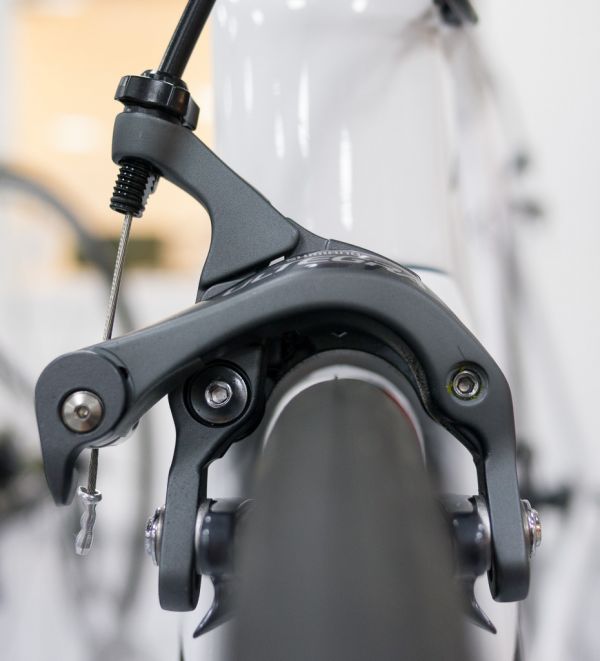 |
| Caliper brake |
For a safe and enjoyable ride, effective brakes are essential. Single-Speed bikes may use any type of brake.
There are three main kinds; Rim, Disc and Coaster Brakes. Rim brakes are most common on urban single-speeds. Their low cost and simplicity matches the low cost and simplicity of single-speed bikes. Rim brakes use rubber pads to squeeze against the wheel rim, in order to slow it. They come in a few varieties.
Rim Brakes
Caliper brakes are attached to the frame or fork by a single bolt. They use curved arms, which must be long and wide enough to fit around your tires. For this reason, they are suited to accommodating narrow to mid-width tires. They are common on a variety of urban single-speed bikes, including town bikes and cruisers. Shimano and Tektro offer reliable mid-level to high-end options.
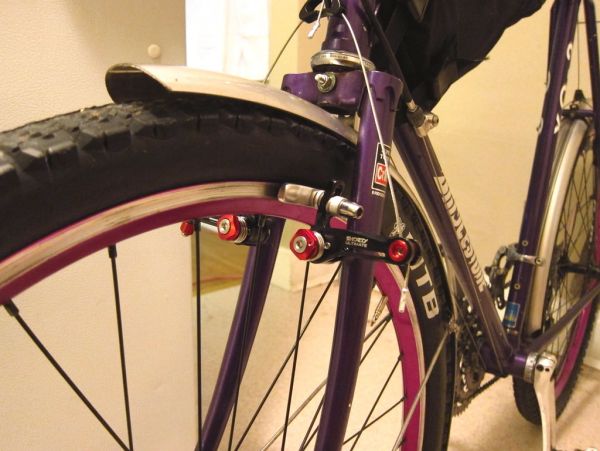 |
| Cantilever brake |
Cantilever brakes use two separate arms, attached to bosses on the bicycle frame. They easily accommodate wider tires. As such, they were popular on older mountain bikes and are now used on modern cyclocross machines. Newer models are powerful, precise and easy to maintain. They are the recommended winter rim brake.
Linear-pull brakes (also known as ‘V-brakes’) are a type of cantilever rim brake that uses a single cable and two arms. They allow room for fatter tires and may be found on offroad single-speeds, cruisers, town bikes and BMX cruisers. They are easily adjusted and maintained at home. That said, they can still be tricky to center.
The most important consideration with rim brakes is that they lose some power in wet weather. Winter braking also wears down rims as grit and filth gets attracted to your brake pads. However, they are cheaper than discs and easier to adjust without professional help.
 | |
| Disc brake (cable-actuated hydraulic) | Linear rim brake (a.k.a ‘V-brake’) |
U brakes are powerful caliper brakes that are sometimes used on 29” BMX cruisers and older mountain bikes. The pivots are mounted directly to the frame and fork.
Coaster Brakes
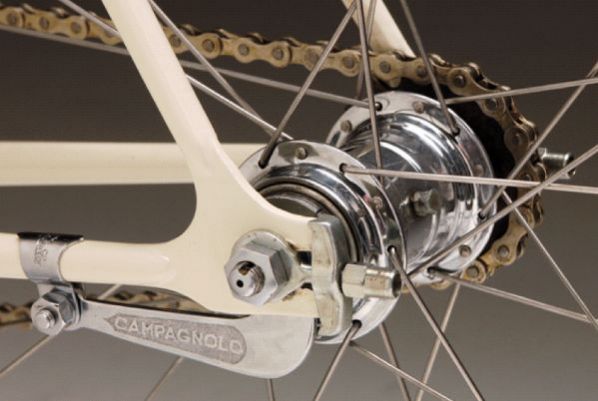 |
| Ye olde Coaster brake |
Coaster brakes are also known as ‘pedal brakes’. You might remember them from childhood, when simple bikes required you to push your pedals backwards to stop. They can be found on some new single-speeds, especially cruisers and town bikes.
There are no pads or discs and braking takes place largely within the wheel hub. Most coaster brakes provide somewhat inferior stopping power, compared to rim and disc brakes. But as with any other brakes, there is a wide range available in terms of quality and cost.
When using a coaster brake, it’s recommended to combine it with a front rim or disc brake. This insures against failure.
Disc Brakes
Disc brakes slow the bike by squeezing pads onto a disc, which is attached to the wheel hub. Discs cost more than rim brakes, but are now more affordable than they have ever been. They are more powerful than rim brakes, especially in wet weather. They allow for the use of wide tires and don’t wear down your rims. Many single-speeders are attracted to simplicity, frugality and a low total weight. For this reason, discs are less common on urban single-speed bikes.
The power offered by disc brakes is more applicable to off-road use. It isn’t uncommon to see them used on single-speed mountain bikes.
Disc brakes add weight to your bike. They are also more complicated than rim brakes; as pertains to maintenance, adjustment and repair.
There are two types of disc brake: hydraulic and mechanical. Hydraulic brakes provide greater stopping power and use brake fluid to transmit force. They are more costly than mechanical discs and trickier to maintain.
If you live in a drier climate, you might consider cutting costs and using rim brakes. But if your priorities are performance and all-weather resilience, discs could be your preferred option.
Gearing
If you see manufacturers mentioning the ‘drivetrain’ of their bikes, they are referring to all the elements that contribute to gearing. On a single-speed, this includes the chainring, chain and a single cog. This cog is either incorporated into a freewheel (which has its own bearing housing) or it is attached to the freehub of a rear wheel that was designed for a geared cassette.
 | |
| A single-speed drivetrain using a freewheel | A freehub using a cog |
Either way, single-speed drivetrains are much simpler than drivetrains on a geared bike. You’ve only got one gear! For this reason, it is important to get your gear combination right for all your riding needs. The correct single-speed gearing is known as a ‘ratio’.
Ratio
Usually, a new bike comes with a ratio suited to an average rider on moderate terrain. You will need to ride your new single-speed for a while before working out if you want an easier or more difficult ratio. You can then consult your local bike shop for help in modfying your ratio. Many single-speed enthusiasts also enjoy learning how to modify their own gearing, as it’s a good introduction to D.I.Y. bicycle mechanics.
A solid starting point for an on-road single-speed ratio is within the range of:
2.3:1 to 2.75:1
 |
| Hill climbs on one gear can be brutal |
Common street ratios on moderate terrain often use a chainring between 42 and 44 tooth. This is combined with a rear freewheel around 16 to 17 tooth. A single-speed with a 44t chainring and 17t freewheel is written as: 44:17. This is equal to 2.6:1.
Single-Speed gearing is usually a trade-off. It’s impossible to find a gear that is easy on climbs and fast on flats. But when a comfortable compromise is found, it can feel just right.
Most cyclists can’t ride a single-speed in hilly or mountainous areas. This is an endeavor reserved for the fittest and most ambitious cyclists. However, if you aspire to improve your level of fitness in general – or to train for geared riding – a single-speed is the way to go.
 |
| Belt-drive 1×1 |
Belt drives use a carbon-fiber belt in place of a chain. They don’t require lubrication and won’t leave oil on your clothing or legs. Belt drives are smooth and silent.
They do require a certain kind of frame design known as a ‘split-frame’ and use a specialized cog or freewheel.
While they can be expensive, carbon belts are usually longer-lasting than chains. They are more common on higher-end single-speed commuters.
Drivetrain Components
On a single-speed, there are less parts than on a geared bike. There are no derailleurs, no gear shifters, no cassettes and no gear cables. This makes maintenance, repairs and upgrades a lot easier and cheaper.
However, it also means that the single chainring and freewheel are under a lot of stress. On a geared bike, this pressure and wear is distributed across multiple chainrings and cogs.
For this reason, it is important to make sure that your new bike uses quality drivetrain components.
Bottom Brackets
The bottom bracket sits between your cranks and is attached to the frame. It allows the cranks to rotate. The modern standard is a sealed cartridge bottom bracket with BSA thread. 68mm is the standard on road-going bikes and will be the easiest to upgrade and replace. Very low-end bikes may still use loose-bearing bottom-bracket systems. If the manufacturer does not specify a sealed cartridge bottom-bracket, be wary. The bottom-bracket takes the brunt of a cyclist’s force.
 |
| Where a bottom bracket fits into your bike – and what it looks like |
A 73mm bottom bracket is more common on a mountain bike. For mountain bikes, they may use a variety of types, including press-fit bottom-brackets and models with external bearings. These are usually more varied, specialized and higher-cost than basic urban models.
 |
| A 46-tooth chainring in place |
Chainring
Your single chainring is the only sprocket being continually worked, day-in and day-out, whenever you ride. Traditionally, single-speeds used a 1/8” width chainring that was wider and tougher than the 3/32” chainrings used on geared bikes. These days, 3/32″ can be more than ample. Look for reliable brands. These include Shimano, FSA, Sugino and Miche. You don’t need the best on a new bike, as you can replace it. But it should be straight and strong, to be safe.
Chain
Both 1/8” and 3/32” width chains are standard on singlespeeds. KMC provide a lot of reliable, entry-level chains on new bikes. There are a number of other brands available too.
Cranks
Quality “three-piece” cranks will be branded. Avoid bikes with no-name parts. They need to be well-machined and strong, especially for climbs – where all your weight is bearing down on them. Some ultra-cheap single-speeds come shod with cranks that bend or even snap. Snapped cranks have been known to cause terrible injury. There are many decent brands and most are made in Taiwan and China. Reliable names include Shimano, FSA, Sugino and Miche.
 |
| A ‘crankset’ on and off the bike. A crankset usually includes both cranks and a chainring |
Freewheels
Most new single-speed bikes use a freewheel. This device has teeth and looks like a cog. It threads on to the rear wheel hub and does all the drivetrain work at the back end of the bike. It’s different to a fixed gear cog because it contains internal mechanisms.
| A freewheel and its internal mechanisms |
Within the freewheel, there are bearings to allow it to rotate smoothly. In addition, there are teeth that engage on parts called ‘pawls’. This is what makes the rear wheel engage as you pedal, propelling you forward. Like your chainring, this component endures a lot of pressure and wear and should be decent quality. On poor quality single-speeds, these can fail to engage and slip. Shimano is a reliable default brand. Dicta make a cheaper entry-level model that works fine, but isn’t as durable.
The Contact Points
The ‘contact points’ are the three places where your body comes in contact with your bicycle. These parts of the bike are not as technically complex as the drivetrain or bottom bracket. Nevertheless, they are incredibly important. Customizing the contact points is relatively inexpensive and can make a huge difference to your level of comfort.
Saddles
Most urban single-speed bikes use the narrow saddles familiar to road bikes. A single-speed mountain bike may use a more padded and robust saddle, that aids comfort and steering on rougher terrain. Riders of cruiser and town bikes sometimes choose plush and squishy seats. However, excessively cushioned saddles can be misleading. This ‘squishiness’ is uncomfortable on longer rides and will be felt as pain in your hips, thighs and bottom. This can cause numbness due to restricted blood supply.
 |
| Generously padded road-style saddle |
A road-style saddle with a little extra padding is a popular style for urban single-speeds.
Moderate padding is ideal, ensuring that your weight is supported by your sit-bones. You might also want to consider ergonomic and health-conscious seats that take reproductive and groin health into account. Saddle choice is highly subjective and most riders will change the seat on their new bike. The easiest way to choose a new saddle is try a few out at your local bike shop.
Grips and Bar Tape
 |
| Mountain bike grips suit flat bars |
Good Grips contribute a lot to comfort. Thin or uncomfortable grips can result in soreness or fatigue. Cheap grips can be made of poor material that wears out quickly. Some riders are partial to ergonomically shaped grips. Again, it’s easier to know what works for you by getting your hands on some examples at your local bike shop.
 |
| Tape adds padding and flair |
Bar Tape.
On single-speeds, bar tape is used on curved ‘drop bars’ (like you see on track bikes) and on ‘bull horns’. Thinner bar tape is more likely to absorb road vibration. This can result in sore hands and wrists, especially after longer rides. Padded bar tape is more likely to insulate against shock on uneven surfaces. An added bonus is that bar tape comes in a variety of colors and patterns, giving you options to stylize and coordinate the look of your bike.
Pedals
If you’re lucky, your new bike will arrive kit with decent pedals. Most likely though, pedals will be the first thing you’ll replace. Even high-end bikes can come with cheap plastic pedals intended for temporary use. Some of the best single-speed bikes are not supplied with pedals at all. Why is this? Pedal preference is very personal and manufacturers expect you to customize them.
Also, what’s the deal with cycling shoes? Are they necessary?
Flat (or ‘platform’) pedals can be made of plastic or metal and usually have some level of grip. You can easily move your feet from the pedals to the ground and back again, without having to ‘clip’ in and out. With flats, you can wear your everyday shoes and there’s no need to carry or store a spare pair at your destination. The main drawback is that they are less efficient than other pedals, particularly on climbs.
 | |
| Flat pedals are stable | Pedal Straps use your existing flat pedals |
Pedal Straps attach to your flat pedals. They are an alternative to clipless pedals and cycling shoes. Pedal straps became popularized during the spike in interest in fixed gear cycling, where they’re useful for skid-stops. For single-speed riders, they offer lift on the upstroke, while being comfortable and easy to wear with casual shoes.
‘Clipless’ Pedals require cycling shoes to use. There is a ‘cleat’ on the sole of cycling shoes, that requires riders to ‘click’ in and out of pedals when removing their foot from them.
There are different systems of clipless pedal, with the most common being Shimano’s ‘SPD’. ‘Time’ pedals are also highly suited to commuting as they allow the rider to quickly click their shoe out to the side of the pedal.
 | |
| ‘Time’ clipless pedal | Shimano ‘SPD’ clipless pedal and shoe |
Clipless pedals increase efficiency, especially on climbs, as they pull the pedals on the upstroke. This is particularly useful on a bike with only one gear. Some cyclists see clipless pedals as daunting, but it takes a very short amount of time to become familiar with them. Once you’re accustomed to clipless, using them soon becomes second nature. You can even buy cycling shoes with recessed cleats. You can walk comfortably in them, without ‘clip-clopping’ along.
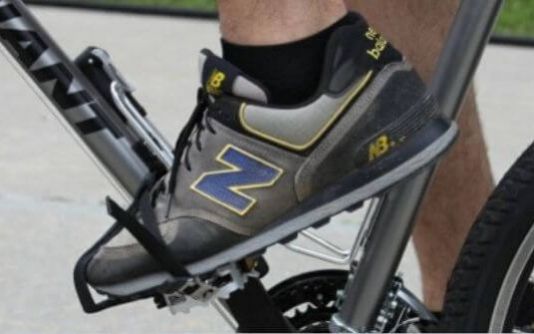 |
| Toe Clips let you wear your own shoes |
Toe Clips are the precursor to clipless. They feature a ‘cage’ over the pedal that allows you to insert any shoe and achieve a similar upstroke pull to clipless pedals. They aren’t quite as efficient as clipless and can be more difficult to use. They need to be snug, but riders also need to slide their shoe backward out of the pedal cage before stopping. A number of cyclists are still dedicated to these pedals.
Along with tires, the contact points are the first parts that owners are likely to replace on a new bike. It’s an easy way to personalize the comfort, feel and style of your new machine. If they feel good straight-out-of-the-shop, there’s no need to swap them out. However, customizing the contact points can radically improve your comfort-level. Saddles, pedals, grips and bar tape are all inexpensive to replace and easy to adjust for novices.
Wheels
There are three main materials that wheels are built from; alloy, carbon fiber and steel.
- Alloy is plenty light and very common. Most commuter wheels use alloy rims.
- Carbon Fiber is light, expensive and strong. It’s rare on single-speed wheels.
- Steel wheels are heavy and rarer on new bikes. Some roadster-style bikes still use them.
What Size Wheels?
A single-speed bike can have wheels of any size. However, most urban single-speeds will use 700c road wheels. These larger wheels translate your single-geared pedal power into the most distance available. Off-road single-speeds may have 29”, 27.5” or 26” wheels. There is no standard, but some sizes are much more common. Here’s the run-down of wheel sizes you’ll find on single-speeds:

700c is the most common wheel size found on single-speeds. It’s the same size as found on modern road bikes. Their large circumference allows them to roll quickly. They are less prone to jounce when passing over small cracks, bumps and debris. Because of their size, they are less agile than smaller wheels and may be heavier than them. The weight penalty is balanced out by by the fact that they roll faster than smaller sizes.
29” (or 29 inches) is the name used to describe wider 700c wheels, as found on some hybrids, BMX cruisers and mountain bikes. They share the same circumference as 700c wheels but usually use wider rims. It’s more appropriate to fit wider tires on these wider rims – and narrower tires on 700c rims. With fat tires on 29” wheels, they can make some bikes too tall for shorter riders. Keep this in mind when sizing up a new bike.
650b wheels are smaller in circumference than 700c, but larger than older style 26 inch mountain bike wheels. 650b has been popular with touring cyclists and randonneurs for many decades, but has recently gained a renewed appreciation and subsequent application to many bike types.
Because of their smaller size, they may be slower than 700c when shod with narrow tires. However, it’s important to note that a 650b wheel with a large 47c tire is the same circumference as a 700c wheel with a 28c or 30c tire. This also means that these tires have more air volume, which translates to increased comfort and jounce-reduction on rough roads.
 |
| A versatile 650b singlespeed |
650b wheels are more agile than their larger 700c brethren – and they also accelerate faster. There is another benefit of these mid-sized wheels – and it’s being capitalized-on by contemporary manufacturers. Using 650b wheels, smaller bike sizes stay in proportion and allow a lower standover height.
If you’re a smaller or shorter rider, 650b is well worth your consideration. Some models come with the option of 650b or 700c. For other models; larger frame sizes use 700c, while smaller sizes use 650b.
 |
| A new-model 26″ single-speed mountain bike |
27.5” is mountain-bike lingo for 650b. They’re the same circumference and diameter as 650b but usually sport wider rims for larger tires and rougher applications. Rims will likely be tough, particularly when coupled with the fat, slick tires that fit best on these rims.
You’ll usually only confront 27.5” wheels on single-speed mountain bikes or some BMX cruisers.
26” wheels used to be the standard on mountain bikes. They are smaller than 27.5” and 650b. As such, they are tough, agile and quickly pick up speed. However, they are noticeably slower than the larger sizes when it comes to maintaining speed over distances.
 |
| This single-speed folder uses 17″ wheels |
You may enjoy these wheels with wide and cushioned tires, if comfort is more of a priority than speed. Some cruisers and town bikes will still use 26” wheels for a plush ride. On single-speeds, they’re usually only found on mountain bikes.
Smaller wheel sizes. Many single-speeds with wheels smaller than 26” are either childrens’ bikes or BMXs. The rare exception is the odd folding bike. These may have wheels anywhere between 16” and 24”. To compensate for the low rolling speed of tiny wheels, these bikes will use a large gear ratio.
Tires
Single-Speeds can use any kind of tire. Urban single-speeds will usually use slick or semi-slick tires, as they are almost exclusively ridden on urban roads.
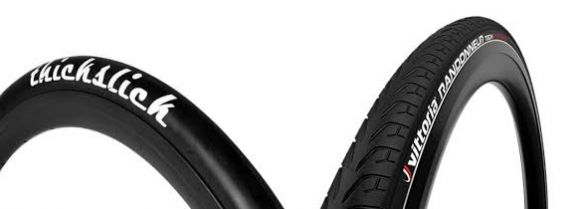 |
| Slick and Semi-slick tires |
For most commuters, slick tires suffice for a large part of the year. Lightly treaded tires may be more appropriate for winter. Of course, if your commute includes dirt roads or particularly neglected asphalt, you might need something more rugged. If you’re into single-speed mountain-biking, you’ll want something chunky with grippy tread.
An important thing to remember is that wider, chunkier and fatter tires add weight. Whether you’re riding on or off-road, it always helps to shed weight from a bike that only has one gear!
Mid-size tires, between 30c and 47c, can be run at lower pressures. This increases shock absorbance, while still being efficient and decently fast. A wider tire creates more traction through a wider ‘contact patch’, meaning that more rubber is in contact with the ground at any given time. For you, this translates to a safer ride with more grip, less slippage and more braking power. This is particularly helpful in wet conditions.
 |
| Mixed-tread tires are versatile |
When choosing tires for your single-speed, the factors to balance are:
- Comfort vs.
- Speed vs.
- Weight vs.
- Traction.
Wider tires are heavier, slower and more comfortable. Thinner tires are lighter, faster, less comfortable and more prone to punctures.
For mixed riding on both asphalt and the occasional gravel-track, a ‘semi-slick’ or mixed-tread hybrid tire will be more versatile. These are often less slick, more grippy and have some knobs or file tread.
Single-speed tire sizes on 700c wheels can vary a lot.They’ll usually sit between 23c and 35c, for an urban bike. These sizes are designated as ‘23c’ and ‘35c’. Anything over 35c can get heavy. Less than 28c is intended primarily for speed and will be firmer, less forgiving and more susceptible to punctures. On 650b tires, sizes between 42c and 47c are popular on city bikes, as they give a similar circumference to a 700 x 28c to 700 x 30c tire.
 |
Sizes are written in the format: ‘700x25c’, where ‘700’ refers to the wheel size (700c) and ‘25c’ describes the tire circumference (in this case, approximately 25mm). You’ll find this sizing written along the side of the tire.
For 700c and 650b, tire sizes are written in millimeters (ie 28c, 35c, 47c). For mountain bike wheel sizes (29”, 27.5”, 26”), they are usually written in inches (1.75”, 1.95”, 2.30”). History has left us with a mess of conflicting sizing standards that can become complicated. There is a more precise, universal reference standard known as E.T.R.T.O., which may either enlighten or confuse you.
Never fear, because we have a breakdown of…
Single-Speed Tire Sizes and Widths
Racier single-speeds will have similar tires to a road bike. The standard is a 23c width.
If you’re a casual city rider, tires 28c and wider will provide more comfort and give you added protection against punctures and curb hits.
Some single-speeders like to rock a combo, with a speedy 23c in the front and a tougher, wider 25 or 28c in the rear.
32c is reasonable as a large size. The upper limit would be about 35c, before tires become heavy and slow. Town bikes and cruisers may have tires as wide as 42c.
Anything narrower than 28c is fast, but more susceptible to punctures and pinch-flats.
29” (29 Inch)
 |
| This BMX Cruiser uses slick 29 x 2.5″ tires! |
29” is the mountain bike version of 700c. You’ll find these on single-speed mountain bikes and 29” BMX cruisers.
A majority of 29” tires are knobbly mountain bike tires. But slick varieties are also available. 29” wheels will use wider rims than most 700c wheels and wider tires are safer on these rims. These fatter tires will be comfortable and tough, but heavier than narrower 700c options.
To know the full range that is suited to your rims, refer to the details printed on the rim or the manufacturer recommendations.
Because 650b wheels are smaller than 700c, they are often fit with wider tires to give them a similar circumference. Their wide volume makes them comfortable and cushioning on bumpy rides. They are increasing in popularity. Subsequently, a larger number of high-quality options are becoming available every day.
Popular sizes for city commuting are between 42c and 47c. 650B x 47c is equivalent in size to 700c x 28c.
If you’re using 27.5” tires, you’re probably referring to a single-speed mountain bike. These rims are the same circumference and diameter as 650b. They are usually wider than most 650b rims and suit a wider minimum tire size than that which can be fit to a 650b rim.
In the single-speed world, 26” tires are mostly seen on single-speed mountain bikes. On roads, they are used by some cruisers and town bikes. 1.5” to 1.9” are some of the narrowest widths available, but these result in a somewhat rigid ride and a slower, smaller diameter wheel. Some 26” rims are not built to handle the high pressures of narrower tires.
The safest tires to use are most likely 1.95” to 2.125” in slicks or semi-slicks.
Anything up to 3.0” can be used on single-speed mountain bikes.
Anything this size or smaller may be used on a single-speed folding bike. Otherwise, it’s probably a BMX.
It’s a good idea to invest in a sturdy pair of tires, with decent grip and puncture protection. ‘Sidewalls’ are the sides of the tires. If they aren’t strong, they can wear out before the tread. They can also puncture or pinch-flat easily. A pinch-flat results from impact with a sharp edge (such as a curb), where the sidewall is ‘bitten’ by the wheel rim. There’s nothing worse than having to repair a puncture every few days.
Good tires are a great contribution to safe riding.
Suspension
 |
The only single-speeds that need a suspension fork are mountain bikes. These days, there are a lot of great big-volume tires that roll fast and act as ample suspension on rough city roads.
For city cycling, suspension isn’t necessary. It adds weight, complication and maintenance needs to a bike. In exchange, it offers a level of shock-absorbance that isn’t usually required for road riding. Suspension is overkill for urban bikes.
 |
| Rare: Full-Suspension |
‘Full-Suspension’ single-speeds are almost non-existent, as their weight would make them inefficient. A bike with front suspension and a rigid rear-end is known as a ‘hardtail’.
For hardtail bikes, you will find noticeable differences between suspension forks of differing qualities. For more detailed information, please refer to our guide to buying a new mountain bike.
The quality of a suspension fork will be reflected in the price of a hardtail single-speed bike.
Mount Up
‘Mounts’ and ‘eyelets’ refer to the drilled holes or mount-points on the frame, where you can attach essential and useful accessories.
Some single-speeders aim for minimalism and don’t care to attach a rack, fitted fenders or a bottle holder. Commuting single-speeders will often seek eyelets to attach a rear rack, at minimum.
 |
| An improvised front rack and bottle cage added to fender and rear rack mounts. |
To avoid wet clothes and a muddy back, it helps to choose a frame that has mount points for fenders. If your single-speed frame doesn’t have them, you can attach a rear fender to your seat post.
‘Bosses’ are the name for eyelets that let you attach a water bottle cage. Many commuters and mountain bikers will want at least one bottle available.
Some single-speed bikes will come ready with all three of the above. This might be something to consider when crunching the numbers on the cost of a new bike. But if you like things clean and simple, feel free to forget ‘em.
Extras and Accessories
 |
| A securely locked single-speed |
These are the most common accessories sought by buyers of any new bike:
Lights. When looking at your options, consider USB-rechargeable lights. They reduce waste and don’t require removable batteries.
Locks. A chunky ‘D-Lock’ or similar is recommended. Cables are usually breakable. Remember to buy a lock big enough to secure your wheel – together with your frame – to something secure and stationery.
 |
| Seatpole-mounted fender |
Fenders. A seasonal essential. If you have mount-points on your bike, you can attach rigid fenders and leave them there all winter. Quite a few single-speeds don’t, but you can buy a removable fender that attaches to your seatpost.
Racks If you use a rack and panniers, you can carry far more than you could comfortably tote in a backpack. This moves weight off your back and shoulders, while lessening the chance of arriving at your destination with a sweaty back.
Consider whether you need panniers – and if you need a front and / or rear racks. They may be too heavy for your single-speed commute – or you might lack the required mounts. Luckily, there are many innovative rack alternatives to consider.
 |
| Options for cargo include a saddle-bag rack (left) or porteur front rack (right) |
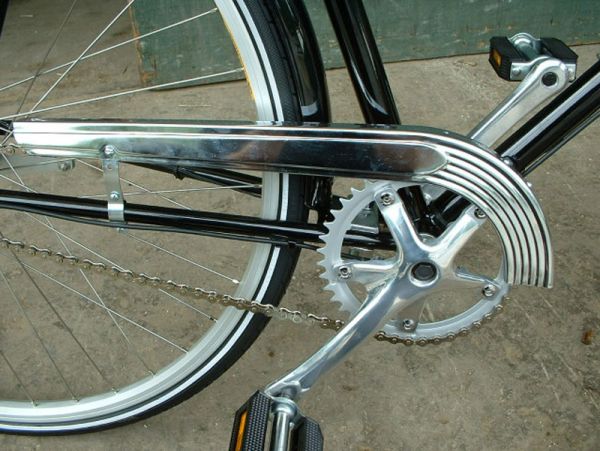 |
Chainguards. This is an accessory that covers the chain and often the chainrings. It protects your legs and clothing from grease. On cheaper bikes, these can rattle and rub against the chain. Higher quality options can be quiet and give peace of mind.
Some single-speeds come equipped with a chainguard, fenders and even lights or a rack. This is definitely something to keep in mind when considering your budget.
Security
As mentioned above, the importance of a good lock can’t be understated. Singlespeeds are often easier to secure than other kinds of bike, especially if they use nutted axles.
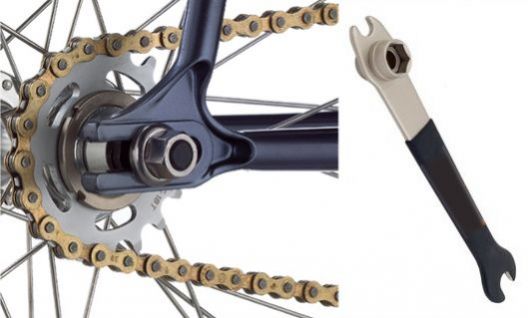 |
| A nutted rear wheel axle and the necessary ‘box wrench / pedal spanner’ |
Nutted axles may require you to carry a tool in order to change a flat tire. However, they can deter thieves by making thievery attempts more obvious. Often, they won’t bother. Quick-release levers make your wheels easy to steal. Your safest bet is to lock your wheels to your frame and to something stationery. You’ll notice that bike messengers almost exclusively use nutted axles.
If you are locking up your bike in public spaces, your safest bet is an inexpensive and nondescript bike. A flashy single-speed is tempting fate.
Simple or ‘Basic’ ?
There are a lot of cheap, new single-speed bikes on the market. In the early 2000s and 2010s, the urban single-speed experienced a renaissance in popularity. This resulted in the market being flooded by a flurry of brands and models. Because of their simplicity, many manufacturers have tried their hand at producing a line of single-speed bikes. Even though they are simple, they can be made poorly. A single-speed’s drivetrain can undergo a large amount of torque and stress.
It’s important to look for a quality frame and components when buying a new single-speed.
 |
| Buyers of this bike reported buckled wheels, ineffective brakes, faulty freewheels and broken welds – when new! |
Super-cheap bikes often come equipped with low-quality components that won’t last. You may think, “Oh, I don’t ride a lot, so it should last a while”, but these bikes can start to fail immediately. They can also make your ride experience miserable. As the parts fail, you’ll end up spending more money on upgrades and repairs. This money could be better spent on a reliable, higher quality bike that you can trust. This is the more cost-effective option.
If you aren’t a cycling enthusiast, most single-speed bikes may look the same. But many of the important factors are not obvious. This includes drivetrain components; such as your bottom-bracket, hubs, chainrings, cranks and freewheel. Frame material is also important to consider (see Frames section).
Brakes may be the most important factor of all (see main Brakes section).
It can be difficult to discern crud from quality, but by reading a wide range of buyer and expert reviews you should be able to make an informed decision.
When it comes to single-speeds, there are many brands producing parts. Too many to memorize! But there are reliable names to look for. When it comes to gearing components, Shimano can be trusted.
Pricing
At the lowest price point, you can potentially buy a new single-speed bike for as little as $100. What you’ll get for this price is basically disposable. Frames are certainly heavy, hi-tensile steel. Components are cheap, heavy, unreliable and subject to imminent failure. Most buyers end up replacing a majority of components within the first year of ownership. Either that or they get rid of it and buy a new one.
 |
| A 29″ BMX cruiser is a solid budget option |
From $270, you can find an alloy, 29” BMX cruiser with a chromoly fork. Some parts are branded. This kind of single-speed is more solid than many skinny road bikes in this price range.
Starting around $330 and up, you can find cut-rate single-speeds that combine some brand-name parts with acceptable no-name components. They will be hi-tensile steel. A good rule is that you can trust a manufacturer that makes mention of the kind of steel they use. If it’s hi-tensile, that’s OK – just know that your ride is a little heavier and a tad more rigid.
From as low as $400, chromoly-steel bikes become affordable. This puts you in a realm where frames are lighter and more comfortable through increased flexibility. Up to about $500, these will still have a mix of branded and generic parts.
Heading up to $500 – $600, bikes use chromoly-steel and aluminum frames, with mid-range branded parts. At this price range you can find bikes that are durable, with components that can be maintained and used for years. There are some good bikes in this range. Higher-end BMX cruisers sit here too.
 |
| $500 to $600 buys a solid chromoly bike |
Between $600 and $800, road and commuter single-speeds will be good to great quality with brand name parts and a considerable weight reduction. Chromoly or aluminum is standard. BMX cruisers are 100% chromoly with high-end components.
$800 to $1200 will see you into the world of high-end single-speed commuters and performance track frames that are drilled for use with front and rear brakes. Disc brakes enter the fray here.
The world of high-end single-speeds is a weird and wonderful one. Here, there are no rules and you will find many types of specialist niche vehicles. Single-speeds never get as expensive as road bikes or high-end mountain bikes and rarely top $2500. They are almost never made of carbon-fiber. In this range, $1200 to $2500 can buy you:
- A high-end commuter with 650b wheels, disc brakes and a carbon belt-drive.
- A titanium single-speed built on an aggressive track frame.
- A beautiful vintage-style single-speed with a leather saddle and grips.
- A single-speed mountain bike with disc brakes and a rigid fork.
- A single-speed mountain bike with disc brakes and a front suspension fork.
- A single-speed cyclocross bike with a carbon fork and disc brakes.
Budgeting
You can spend the absolute minimum on a single-speed and end up dealing with rapidly failing components, repair fees and the cost of shelling out for replacement parts.
 |
| A mid-priced single-speed can be resilient |
You can spend top-dollar on a sexy street-machine or mountain bike with top-end parts. If you ride for recreation, racing or fitness and aren’t going to be locking your bike up in public areas, it’s no problem. If you usually commute or run errands on your bike, it might not be such a great idea. A lightweight track frame with skinny wheels might not cope with rough streets and curb hits. It will eventually get scratched and probably attract thieves.
You can spend moderately, compromising between performance and cost. Aim for a sturdy, low-key, medium-weight bike with resilient parts. This type of machine can last you for years as a commuter and run-around.
Sizing
Most manufacturers will have a range of sizes available for each bike. In the U.S., this is given in inches. If you aren’t an experienced cyclist, this may hold little meaning for you. Don’t fret.
Basic sizes may be given as: S / M / L / XL – or similar. Each of these sizes should have a height range associated with them (for example, M = 5’7” to 5’10”). These are great as a rough guide, however…
 |
| A single-speed geometry chart |
There’s no such thing as an ‘Average Medium’: Sizing is not the same across all bikes and manufacturers. A ‘Medium’ on one model can be the same as a ‘Large’ in another model. In addition, we all have differing proportions, in comparison to our full height. Some of us have shorter or longer arms, legs or torsos.
More specific measurements are given in centimeters or inches, relating to frame size. This often refers to the length of the seat tube. For mountain bikes, inches are used (ie 14”, 16”, 18.5”, 20”). For road bikes, it’s in centimeters and will look like: ‘52cm’, ‘55cm’, ‘58cm’ etc. Commuter bikes may be measured in either centimeters or inches. This may allow you to get a ‘frame of reference’ (if you will) in comparison with different models and other bikes you have owned, but even these sizes vary from manufacturer to manufacturer and between bike styles (a 52cm town bike is very different from a 20.5” mountain bike).
If you’re determined to perform your entire bike purchase process online, you’ll have to check the manufacturer’s ‘Geometry Charts’ and compare these measurements to your own (after measuring your own ‘reach’, ‘standover’ etc). These charts may seem complicated at first, but learning how to read them is rewarding.
Measuring Up
 |
| At least 1″ between you and the top-tube |
‘Standover’ height is the distance from the ground to the top of the top tube. If the bike has a sloping top tube, this measurement is taken halfway along the tube. In urban areas, you’ll be regularly stopping and starting in traffic and having to put a foot or two down at the stop lights. When you have both feet flat on the ground, there should be one to two inches between the top tube and your precious assets. Measure your inseam with a measuring tape and add this ‘one to two inches’ to attain your optimum standover height.
 |
| Step-through bikes suit casual dress |
Saddle height will be easy to adjust if you purchase a bike with an appropriately-sized frame. If the frame is undersized, you may not be able to raise the seat up high enough because you’ll run out of seatpost. If the seatpost is raised past its ‘maximum insertion level’, it can fatigue, bend or break. If your frame is too big, you won’t be able to lower the seat enough and your standover will be nonexistent, exposing you to potential groin injury. Yowch.
A ‘step-through’ style bike suits riders who prefer to wear dresses, skirts or jeans while riding, or anyone who wants an easier time of swinging a leg over the top tube.
Reach is the distance from your saddle to your handlebars. Too long – and you’ll be stretched out. This will not only cause soreness, but will reduce your visibility and your handling dexterity. Too short – and you’ll feel cramped and excessively upright. Maybe your elbows will knock your knees.
 |
| Overreach (left) and correct reach (right) |
How to Be Certain?
You can find online guides that explain how to measure yourself for an approximate fit, but the best solution to this problem is to visit your local bike shop. They can offer you a professional fit and match you to appropriate bikes. You can even test-ride bikes and get a feel for the size and type that suits you.
Choosing a Single-Speed
Before you make a selection from the myriad choices out there, here are some key criteria to consider.
Purpose
- Will your new single-speed be your daily commuter?
- Do you use it mostly for short trips, errands and shop runs?
- Are you dedicated to single-speed racing or long distance riding on roads?
- Do you heed the call of single-speed mountain biking or cyclocross?
Knowing your riding intentions will help you find the best single-speed bike for your needs. Most new single-speeds are sold as simple urban bikes for casual riders. You can further simplify your choices by focusing on your…
Riding Style
If you like a comfortable, mid-weight bike that can attain decent speeds while offering good visibility in traffic, you’ll probably aim for an Urban Single-Speed.
If you want one bike for all your needs, consider a Do-It-All type single-speed.
If you’re a strong rider that’s dedicated to high speeds and agility, a Single-Speed Road Bike or Track Frame will suit.
If your style is more easy-going, a step-through Town Bike (or even a cruiser) may satisfy.
For cruising comfort, indestructibility, wheelies and style – take a look at a 29” BMX Cruiser.
For specialist disciplines, seek out a Single-Speed Cyclocross or Mountain Bike.
Terrain
There are a number of mid-priced single-speeds that can handle rough city streets and light gravel equally well. Some road-only bikes are more lightweight and delicate.
Carrying Capacity
Is cargo a concern? Keep in mind that some single-speed frames don’t have mounts for racks. The same will go for most track bikes.
With these factors in mind, let’s move on to choosing from the single-speed types.
Types of Single-Speed
Urban / Everyday
 |
| A refined and practical urban single-speed |
Most new single-speed bikes fall into this category.
Build
These bikes are usually built similarly to classic road bikes and modern touring bikes. This means that frame tubing is narrow but not delicate, compromising between moderate weight and strength. They are tougher than race bikes but not as heavy or resilient as mountain bikes.
An urban single-speed can be used by any cyclist over shorter distances or in flatter areas on sealed roads. Otherwise, they suit riders who possess an extra level of fitness or are looking to gain it.
Ride Position
Ride position is usually ‘semi-upright’, as these bikes have flat handlebars. This offers good visibility in urban areas. Frame shapes vary, from more aggressive and leant-forward, to laid-back and upright. They are less aggressive than a road bike.
Weight
Urban single-speeds with chromoly steel frames will usually weigh between 17 and 25 pounds, depending on how robust they are. Bikes with hi-tensile steel frames can weigh up to 35 pounds. On a single gear, this upper weight limit will quickly exhaust most riders.
Frame Material
Steel is common. Chromoly steel frames are compliant and forgiving on rough surfaces. They are lighter than their Hi-Tensile steel counterparts and cost slightly more. ‘Hi-ten’ is cheaper, heavier and jouncier, without having a strength advantage over chromoly. Aluminum frames are also available.
Wheels
Wheels are almost always 700c. Some of the smallest bike sizes may be made for 650b wheels. A few new models use 650b wheels with ‘plus-size’ tires.
Tires
When commuting, most single-speeds will use tires between 25c and 35c on 700c wheels. 650b wheels will often use tires between 42c and 47c. These sizes are chosen in order to cope with rough city streets, while still maintaining speed.
Tire Clearance
Keep in mind that some new urban single-speeds only have enough room in the frame for narrower tires (up to about 28c). Skinny tires are fast and light, but may be less comfortable and resilient than mid-width tires.
Mounts
Urban single-speed bikes may or may not have rack mounts, fender mounts or bottle bosses.
Drivetrains
Most drivetrains are similar and use a chain with a single chainring and freewheel.
Ratios
Ratios on new bikes are usually around 2.3:1 up to 2.75:1. You’ll find chainring/ freewheel combinations with a 42 to 44 tooth chainring and 16 to 20 tooth freewheel. 44:16 and 44:17 is common, with some as steep as 48:17. They are suited to a town of moderate elevation for a rider of moderate fitness. This allows for a compromise between climbing ability and moderate speeds on flats.
Brakes
Most models use caliper rim brakes. Some models use a coaster brake, sometimes in conjunction with a front caliper brake. Coasters are more common on older bikes.
Distance
For most people, urban single-speeds suit short to medium rides and flatter terrain. If you are a stronger cyclist or looking to become one, you might consider these bikes for longer jaunts.
Urban single-speeds with hi-tensile frames can be bought for as low as $100. But at this price, you get what you pay for. Hi-tensile bikes with better components can be bought for around $300. Chromoly steel options, with mid-range components, start at around $450.
Strengths
- Cost. Many decent, low-cost options are available.
- Flexibility. It’s a generalist’s city bike.
- Security. It’s of least concern if your bike isn’t flashy.
- Flip-Floppin’. A ‘flip-flop’ hub helps riders learn fixed gear riding.
- Maintenance. Parts are easily sourced, interchangeable and standardized.
Compromise on…
- Speed. They’re less racy than track bikes.
- Comfort. Tires can be narrow. Town bikes and BMX cruisers are more casual.
- Strength. Not for off-road use, gravel roads or trick-riding.
- Weight. They aren’t as light as a high-end track bike.
‘Do-It-All’ Bike
 |
| Wider tires, beefier tubing. A workhorse. |
Build
These are ‘all-rounder’ bikes that are made a bit tougher than your average city single-speed. Construction is a bit sturdier, tire clearance is a little bigger.
A do-it-all bike can handle the roughest city streets, in addition to hardpack dirt roads and some gravel. They are more practical and less racy than aggressive models. They make good workhorses and can serve as delivery bikes.
Ride Position
Ride position is semi-upright with flat handlebars. This offers good visibility in urban areas and off-road conditions. It’s also a bit more casual.
Weight
Do-it-All rigs start at around 19lb, with the more beefy examples getting up around 27lb.
Frame Material
Chromoly steel is the most common material here. It’s tough and compliant over broken roads, even when loads are toted.
Wheels
Wheels are mostly 700c, with more plus-size 650b examples becoming available.
Tires
Tires on these bikes are wider and tougher than on urban single-speeds. 30c to 35c is a decent average size.
Tire Clearance
Clearance is more generous than on urban and race single-speeds. Maximum clearance is around 38c to 45c, allowing you to fit cyclocross and gravel tires for off-road use.
Mounts
A good do-it-all bike has mounts for at least one rack, one bottle cage and fenders.
Drivetrains
Standard single-speed drivetrain: one chainring, one freewheel and a chain.
Ratios
Ratios are often a little lower than on lightweight and aggressive bikes. Maybe 2.5:1 (ie 46:18).
Brakes
Quite a few of these rigs use linear (V-brakes) to accommodate larger tires than street bikes, while keeping prices down. But there isn’t any standard.
Distance
These bikes are comfortable to ride any distance, short or long, at a moderate and even pace.
$800 to $1300 gets you a resilient, reliable and durable bike with hardy components.
Strengths
- Build. They’re tough enough to knock around whilst carrying cargo.
- Flexibility. It’s a commuter, work-bike, even a gravel or cyclocross bike.
- Durability. The do-it-all will serve you dutifully, for years.
Compromise on…
- Speed. They’re not race bikes.
- Weight. They aren’t heavy but they outweigh race and track bikes.
Single-Speed Commuters
 |
| Comfort, utility & a belt-drive! |
Build
Strong, with mid-width tubing similar to touring bike construction.
Primarily for commuting and urban use. Resilient enough for hardpack and some gravel. Suits weekend jaunts.
Ride Position
Varies, but more or less upright geometry. Top tubes may be slightly sloped for extra standover.
Flat handlebars for upright visibility.
Weight
23lb to 27lb is about average.
Frame Material
High-end Chromoly steels and Aluminum are common.
Wheels
650b is common on this new style of bike. 700c specimens are also out there.
Tires
650b x 47c is the current favorite.
Tire Clearance
650B x 47C or 700C x 35 to 45C.
Mounts
This is an urban utility bike. It should have mounts, eyelets and/or bosses for racks, fenders and bottle cages.
Drivetrains
Both chain and belt-drives are common.
Ratios
Ratios are slightly higher than 700c urban single-speeds, to compensate for 650b wheels. 2.45:1 to 2.75:1 is a common range for new models.
(44:18 chain-drive and 55:20 belt-drive are examples).
Brakes
Brakes are usually discs. Mechanical options are common.
Distance
These bikes offer a comfortable ride, for as far as you can pedal in one gear.
Available models use quality components and construction.
Expect to pay $1200 to $2000.
Strengths
- Quality. Component selection is considered well.
- All Weather Capability, provided by a stable frame and disc brakes.
- Comfort. 47c tires provide high speeds combined with maximum comfort.
- Utility. These are practical bikes, with provisions for racks, fenders and bottles.
- Versatility. This could be your single-speed gravel ride and weekend rambler.
- Safety; via disc brakes, high visibility and tough construction.
Compromise on…
- Price. This level of quality comes at a suitable price.
- Weight. Weights are moderate, but not super-light.
Single-Speed Road Bikes and Track Frames with Brakes
 |
| Race-bred, single-speed, road-specific. |
Build
These bikes are built with speed and agility as a priority over strength. Track bikes are built with the intended purpose of velodrome racing. Many track frames are not drilled to attach brakes.
They are used by folk who prefer to ride and race single-speed, over both short and long distances. Street riders love adapting a track frame to urban use. Messengers often use customized single-speed and track frames.
Ride Position
A fast single-speed may have either drop bars or flat bars. Either way, it puts the rider in an aggressive stance, leaning forward. More-so with drop bars.
Weight
Aggressive single-speeds are usually quite light, even though weight isn’t the primary concern here. Conservatively, 15 to 22 pounds is likely.
Frame Material
Chromoly steel is popular in this range. Aluminum is also used, to a lesser extent. Track frames are built tough, to withstand the severe lateral forces of velodrome racing and hard pedaling. However, they may not be so robust when confronted with the rigors of street-riding and curb hits. Single-speed racing bikes often use tubing similar to that used on tougher road bikes.
Wheels
Wheels are almost always 700c.
Tires
Tires are slick and usually narrow, between 19c and 28c.
Tire Clearance
Tire clearance may be less than on an urban single-speed, and may be limited to 25c. True track bike frames are designed to use tires between 19c and 22c, but may allow for slightly more. Upper limit on a racy single-speed is probably 28c.
Mounts
Urban single-speed bikes may or may not have mounts or bosses for racks, fenders or bottle cages. Many track frames have none of these mounts.
Drivetrains
Most drivetrains are similar and use a single chainring, freewheel and chain.
Ratios
As these bikes are usually ridden by single-speed enthusiasts, they may have steeper ratios than a casual urban bike. They’ll be closer to the 2.75:1 to 3.0:1 end of the scale. 46:17 to 48:16, for example.
 |
| This track bike has a frame that is drilled to attach both front and rear brakes |
Brakes
Brakes on single-speed road bikes are mostly caliper rim brakes. It’s important to note that many track frames aren’t drilled for brakes and even if you replace the fork with one that is drilled for a brake, you will only have one brake available. In an emergency, sudden front braking can be dangerous.
Distance
An aggressive single-speed is more attuned to longer distances than an urban single-speed. Track bikes are very aggressive and suit short, fast sprints or longer rides for a niche few.
These bikes are more refined than your average, casual single-speed and will set you back anywhere from roughly $800 to $1200.
Strengths
- Speed. These bikes are made to ride and accelerate quickly.
- Agility. Aggressive street bikes exhibit sharp, tight handling.
- Fitness. Theses bikes will either use or build strong calves and quads.
- Weight. The lightest single-speeds are in this category.
- Fun. Few bikes deliver the simplicity and thrill of a fast single-speed.
Compromise on…
- Price: These bikes use higher-end parts to ensure performance at speed.
- Versatility. Track frames usually don’t have any mounts.
- Strength. Many of these frames are more delicate than urban single-speeds.
Fixed Gear Bikes – “Fixies”
 | ||
| Track bike | Flat-bar on track frame | Single or Fixed with a flip-flop hub |
Build
Fixed gear bikes can use any frame that is used by a single-speed. Track bike frames are more commonly used by fixed gear riders than by single-speeders in general (see above). Track frames do not feature mount points to attach brakes, as they are built for velodrome use.
Fixed gear bikes can be ridden by many cyclists over shorter distances or in flatter areas. Otherwise, they suit riders who possess an extra level of fitness or are looking to gain it.
Ride Position
Ride positions are similar to those found on singlespeeds.
Weight
Weights are comparable to those of singlespeed bikes.
Frame Material
The same frame materials are used for singlespeed and fixed gear bikes.
Wheels
Wheels are almost always 700c. A small number of riders experiment with 650b wheels.
Tires
Tires are similar in size to those used on singlespeeds. As the rear tire is ‘skidded’ to brake, it’s a good idea to have a tough, high quality rear tire. A wider tire can provide a large contact patch for stopping.
Tire Clearance
Tire clearances are similar to those of singlespeeds. True track bike frames are designed to use tires between 19c and 22c, but ‘street track’ frames may allow for rubber up to 25c.
Mounts
‘Fixie’ frames may or may not have mounts or bosses for racks, fenders or bottle cages. Many track frames have none of these mounts.
Drivetrains
Most drivetrains are external, with one chainring and a single cog that is fixed onto the rear hub. This means that the rear wheel keeps moving as long as the pedals rotate. They move in unison, linked by your chain. You can’t coast on a fixed gear bike.
Ratios
Fixed gear ratios tend to be higher than on your average single-speed. Because you will be continuously pedaling on descents, it’s more comfortable at a lower cadence. 2.75:1 is a good starting point.
Brakes
The maximum number of rim brakes used on a fixed gear is usually one. This is a front brake. The rear fixed cog acts as a brake but this technique takes some effort to master. Some skilled riders (including bike messengers) use only the rear fixed hub to stop. This is illegal in many areas and does not provide instant braking. It’s more of a skid and can be dangerous if a chain were to break. A front brake is encouraged.
Distance
For most people, fixed gear bikes suit short to medium rides and flatter terrain. If you are a stronger cyclist or looking to become one, you might consider a fixed gear bike for longer jaunts. The need to ‘always be pedaling’ can be tiring if your quads aren’t up to snuff.
Fixed gear bikes can be much cheaper than other options. That said, it isn’t uncommon for enthusiasts to pay more for good looking bikes with exotic components.
Strengths
- Maintenance doesn’t get any simpler than with a fixed gear bike.
- Weight. Most fixed gears are lightweight.
- Cred. The ability to ride a fixed gear can muster respect in some circles.
- Aesthetics. A clean, stripped-back fixed gear can look pretty darn good.
- Fitness. Fixed gear bikes can contribute to a higher level of fitness.
- On climbs, the momentum of a fixed drivetrain ‘propels’ you forward.
- ‘Riding fixed’ uniquely synchronizes your movement with the bike’s machinery.
- Security. Low-key fixed gears won’t attract thieves and can be inexpensive to replace (Most thieves can’t ride a fixed gear bike!)
Compromise on…
- Ease. With only one gear, they require greater fitness for climbs and long distances.
- Distance. Many cyclists are only able to ride shorter distances on a fixed gear bike.
- Security. Flashy fixed gear bikes are more stealable, due to their elevated level of radness.
- Safety, especially if a chain breaks. Riding a fixed gear requires practice.
- Comfort. Riding a fixed gear requires concentration and can be fatiguing.
The Difference Between Single-speeds and Fixed Gear Bikes
On a fixed gear bike, you can not coast. When the bike is moving, you are always pedaling.
On a singlespeed, you can coast. Rolling down hills without pedaling is no problem. Many singlespeeds come with a ‘flip-flop’ rear hub. This has a fixed-gear cog on one side and a coasting freewheel on the other. This allows you to ‘flip’ between the two, giving you a chance to practice fixed gear riding or to choose to ride fixed, seasonally.
Town Bikes
 |
| A Hi-Tensile, 26″ step-through with rack mounts & U-brakes |
Build
‘Town bikes’, ‘City Bikes’ and ‘Dutch Bikes’ are heavy, solid, upright and casual. Classic, sweeping shapes with step-through frames are popular. They have a low standover height and suit wearing dresses, skirts and casual clothing.
These bikes suit short, cruisy commutes.
Ride Position
You sit very upright on these bikes. They often have wide, swept-back bars that leave the arms akimbo.
Weight
There’s no getting around it. Town bikes are almost always heavy.
Frame Material
Frames are usually steel (and frequently heavy, jouncy, high-tensile steel at that). Sometimes, aluminum.
Wheels
Wheels are often 700c (sometimes written as 28” which is an older ‘roadster’ size). Older bikes actually use a rarer size 28” wheel. They may also be 27.5”, 650b or 26”.
Tires
Rubber is often at the fat end of the spectrum, from about 32c to 38c.
Tire Clearance
Town bikes will often allow for wide “balloon tires”. These can reach 700c x 50c or 60c in width.
Mounts
Town bikes may come fit with a basket or rack. They often have rack and fender mounts. They may or may not have a mount for a bottle cage.
Drivetrains
Most drivetrains use a single chainring, freewheel and chain. Chainguards are common.
Ratios
Closer ratios are specified on town bikes. This makes it easier to move their heavy weight while seated in the classic upright manner.
Brakes
The Town Bike is heavy and must be stopped. In the rim brake category, we have V-brakes and calipers. Coaster brakes still exist on some new models. Disc brakes are rare.
Distance
A town bike welcomes a short ride. They’re great for brief commutes, errands, corner-store trips, riverside ambles and picnics.
Most town bikes are a cheerfully cheap, low-cost option. They’re simple and not necessarily low-quality.
Strengths
- Comfort. They’re relaxed and upright, with wide bars for cruisy boat steering.
- Resilience is a hallmark of well-built Town Bikes, e.g. the traditional Dutch Bike.
- Maintenance is minimal and usually simple.
- Baskets and Racks may come included with your town bike.
Compromise on…
- Weight. Tradition dictates that sturdiness and durability are priorities.
- Climbing Ability, due to the upright ride position, close ratio and weight.
- Distance, also due to the upright ride position, close ratio and weight.
- Speed. Again; due to the upright ride position, close ratio and weight.
29” BMX Cruisers
 |
| Low-cost, tough & comfy, with bigger wheels than a road bike |
Build
This is the Big-Kids’ BMX. Fat-tired, twenty nine inch wheels have a bigger diameter than 700c wheels on a road bike. This makes them fast enough to be practical as a commuter, while being built as tough as any other BMX.
There are two main uses for the BMX cruiser. In one camp are the chill riders, who just want a relaxed and comfy run-a-bout for casual rides. The other group are trick-riders and wheelie afficionados.
Ride Position
BMX cruisers usually have the seat low, bars high and ‘slack’ geometry for a laid-back ride.
Weight
These bikes are tough, not light. A lot of bikes are around 29lb, while 28lb to 34lb is the range.
Frame Material
Chromoly steel is the preferred material for the BMX cruiser. Some aluminum examples exist.
Wheels
Wheels are 29 Inches.
Tires
Tires are slick and fat, for comfort and big hits on roads, between 2.10” and 2.5”.
Tire Clearance
Tire clearance is generous. Up to 2.5”.
Mounts
BMX cruisers usually do not have mounts or bosses for racks, fenders or bottle cages. Front racks can be attached to some forks.
Drivetrains
Most drivetrains are similar and use a single chainring, freewheel and chain.
Ratios
Ratios are usually lower than on other single-speeds, to enable slow-speed cruising on these heavy rigs. Ratios also need to suit wheelies and tricks. Anywhere from 1.95:1 to 2.44:1 can be found on new bikes. Chainrings and sprockets are both smaller than on most racier bikes. Expect 33:16 / 36:16 / 30:13 or similar.
Brakes
Most BMX cruisers come equipped with one rear brake. Most often, this is a linear (V-Brake) or U Brake. You can always attach an additional front brake.
Distance
BMX cruisers are heavy but comfortable and suit short to medium distances.
There is quite a wide range in quality, weight and style. Anywhere from $300 to $1000 can be expected, with a lot of good options around the $550 to $750 mark.
Strengths
- Indestructibility: …or close to it. BMX cruisers are near bombproof.
- Comfort. Laid-back, with massive tires and a relaxed riding position.
- Fun. If so inclined; you can jump and wheelie these rigs.
- Price. 29” BMXs are a budget alternative to a sturdy 700c bike.
- Style. There are some visually and structurally impressive rides on the market.
Compromise on…
- Weight. BMX cruisers are hefty.
- Speed. With the stock ratio and extra weight, don’t expect to break records.
- Mounts. They usually don’t have any.
Single-Speed Mountain Bikes
 |
| A rigid, 27.5″ single-speed MTB |
Build
They’re made for off-road use.
Ride Position
Varies, but a slack top tube allows a lower saddle height to keep weight toward the rear on descents. Flat handlebars keep you upright.
Weight
Heavier than a single-speed road or track bike. However, with high-end and lightweight steel and aluminum tubing, they can be of similar weight to many urban single-speeds. 20 to 28lbs.
Frame Material
High-end Chromoly steels and Aluminum are common.
Wheels
Strong alloy wheels in 29”, 27.5” and 26”.
Tires
Wide tires for off-road use, roughly 1.95” up to 3.0”. Anything wider is difficult to push with one gear.
Tire Clearance
A maximum clearance of at least 2.4”. Clearances may reach 3.0”.
Mounts
Single-speed mountain bikes will probably have bottle cage bosses. They may or may not have mounts and eyelets for fenders and racks.
Drivetrains
Drivetrains usually use a chain and may use either a freewheel or a single-speed conversion kit on a freehub.
Suspension
Many single-speed mountain bikes are run rigid (no suspension fork), to cut weight and maintain simplicity. Other single-speeders do choose to use a suspension fork. Hyper-niche, full-suspension single-speeds are rare.
Ratios
1.8:1 to 2.0:1 is a common range for new models. (32:16 to 32:18 is common).
Brakes
Brakes are mostly discs. V-brakes and cantilevers are more common on older bikes.
Distance
Mountain bikes are heavy and suit trail jaunts, but you can ride single-speed all day if your quads are buff.
These are specialist items. But without incorporating gearing (and often suspension), they can be had for a lot cheaper than a mountain bike of similar quality. Entry-level: $350-$700. Mid-level: $1500-$2000. Belt-drive and full-suspension: $2800 and up.
Strengths
- Strength and Durability. Tougher than any other single-speed.
- All-Weather Capability is provided by a stable frame and disc brakes.
- Comfort. Laid-back geometry and fat tires for that ‘couchy’ ride.
Compromise on…
- Weight. SS mountain bikes can tire the fittest rider. They’re overkill for cities.
- Speed. Fat tires are heavy and slow on-roads.
- Price. Entry-level models are rare. Some specimens are boutique items.
- Versatility. SS MTBs have a defined niche: ‘less-mountainous mountain-biking’.
Single-Speed Cyclocross Bikes
 |
| This high-end rig uses cantilever brakes |
Build
Strong and light.
Off-road, drop-bar racing. Very adaptable to being a road or urban bike.
Ride Position
These bikes are made to be ridden in the drops. Even so, slightly-sloped top-tubes give more standover than a road bike. They are agile.
Weight
Weights vary with price, but they can be impressively low while remaining robust. Bikes are for sale from 13lb to 25lb. Cyclocross riders have to occasionally carry their bikes.
Frame Material
High-end Chromoly steel is a favorite. One new, lower-priced model is Scandium with a carbon fork.
Wheels
Strong alloy wheels in 700c.
Tires
700 x 35c is the cyclocross standard. Sometimes 33c.
Tire Clearance
Tire clearances are usually designed around 35c tires.
Mounts
Single-speed cyclocross bikes will usually have bottle cage bosses and fender mounts. They may or may not have mounts for racks.
Drivetrains
Drivetrains usually use a chain and may use either a freewheel or freehub.
Ratios
2.3:1 to 2.6:1 is a common range. 42 tooth chainrings are common.
Expect: 42:16, 42:17, 42:18.
Brakes
Cantilever rim brakes and mechanical disc brakes are both popular.
Distance
These bikes are built for cyclocross races, but are comfortable to ride over medium to long distances. You may not want to ride shorter distances in the drops.
There’s a wide range of prices. Most bikes fall into the $950 to $1200 range.
Strengths
- Strength and Durability. These are tough bikes, built well.
- All-Weather Capability. CX bikes want to be ridden through mud and rain.
- Speed. You can tuck in and gun it, down on the drop bars.
- Versatility, as a single-speed long-haul commuter, road bike or gravel bike.
- Weight. Considering their strength, these bikes are lightweight.
Compromise on…
- Price. These bikes start in a higher bracket than urban singlespeeds.
- Comfort. They’re a bit racy and many models are fit with drop bars.
- Urban Use. Without flat bars, visibility is reduced in urban settings.
- Security. A flashy bike is more likely to be stolen.
Direct Sales vs. Local Bike Shop
 | |
| Over-the-counter… | or box-fresh? |
Buying a bike online is a world apart from the experience of choosing a bike from your local bike shop. The benefit of a direct sale from the manufacturer, is that you aren’t paying for the middleman. If you’re buying a bike from an online retailer, they don’t have to pay for rent of premises and they don’t need to pay an experienced, professional mechanic to assemble and tune your bike. For these reasons, you pay less.
On the downside; you don’t get the benefit of sitting on the bike, test-riding it or getting a feel for it. Even looking at your prospective purchase ‘in-the-flesh’ can be reassuring. Your local bike shop (or ‘L.B.S.’) will assemble, tune and fit your bike for you before you ride away. They will usually offer you a warranty deal and a minor servicing for free within the first few weeks of purchase.
Whatever route you choose, there are benefits and drawbacks. However, if you’re not a DIY mechanic, assembling and tuning your bike may be a learning process that requires the purchase of tools. Once your bike is delivered, it’s highly recommended that you take it to your L.B.S. to have it professionally assembled and tuned. This will ensure that you can feel safe and certain that your bike is protected from any undue wear.
One and Done
Single-Speeds are simple bikes, so buying one shouldn’t be complicated. There are a lot of manufacturers offering their own models.
 |
| For some folk, one gear is enough |
At first, the choice can seem overwhelming. But options are easily narrowed down by focusing on your needs, priorities and riding style.
When it comes to single-speeds, a moderate price should buy you a decent bike. In comparison to a geared bike of similar quality, your money goes a lot further. In return, you get a low-maintenance bike that lets you either step up to the next level of fitness or just take it easy.
Choose wisely and ride on!
Owen Jesse
Owen has spent decades building and riding bikes; as a messenger, photographer and for an environmental non profit. He’s volunteered teaching others to fix their bikes and loves a genre busting bike build.
Источники:
https://ironking.ru/articles/poleznoe-o-trenazherakh/oboruduem-zonu-dlya-sayklinga/
https://www.outsidepursuits.com/best-single-speed-bike/
https://bikeincity.com.ua/obzor-schwinn-cutter-pravilnyj-gorodskoj-singlspid/
https://www.thrillappeal.com/best-single-speed-bikes
https://www.bikeride.com/best-single-speed-bikes/
